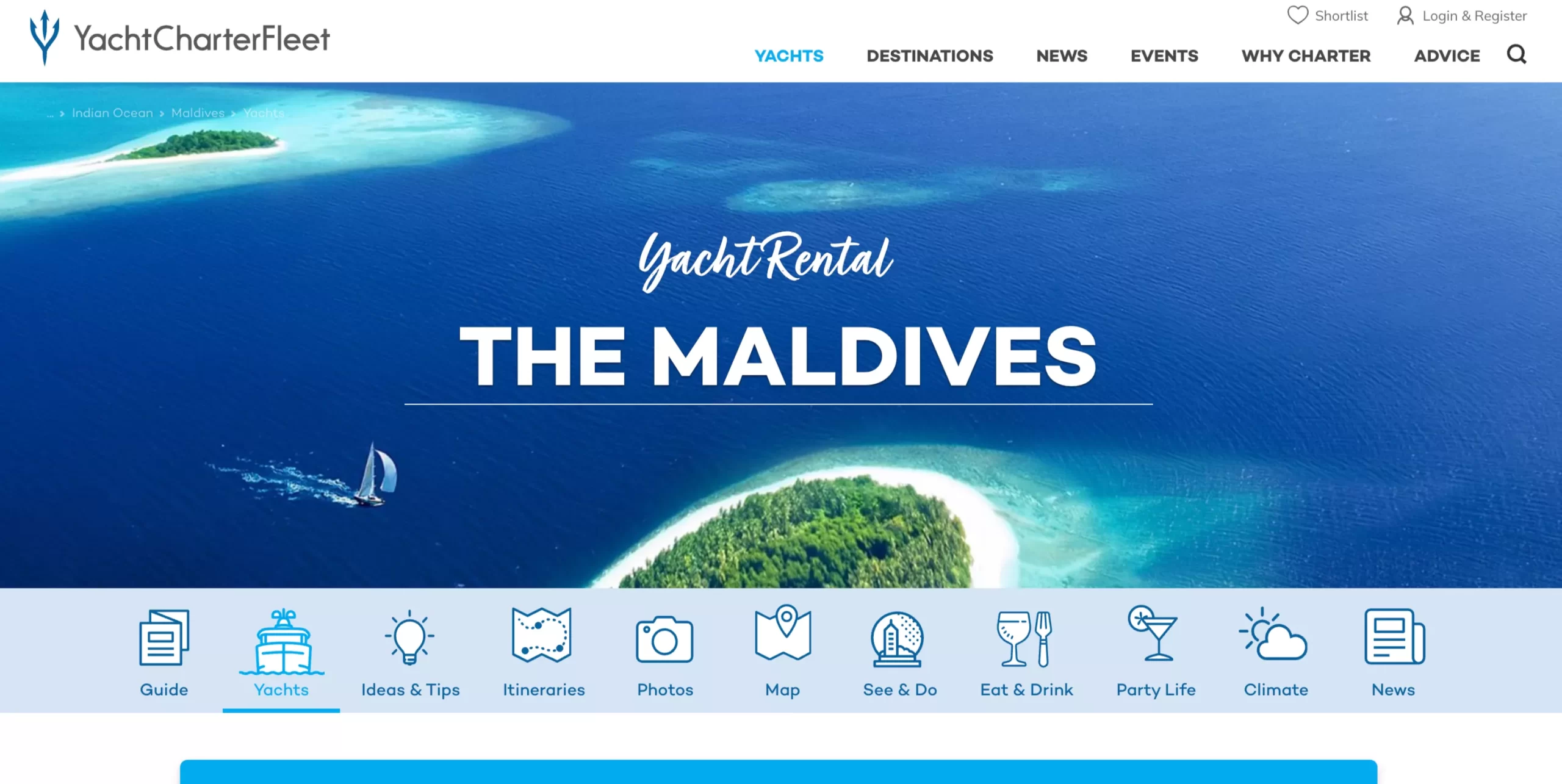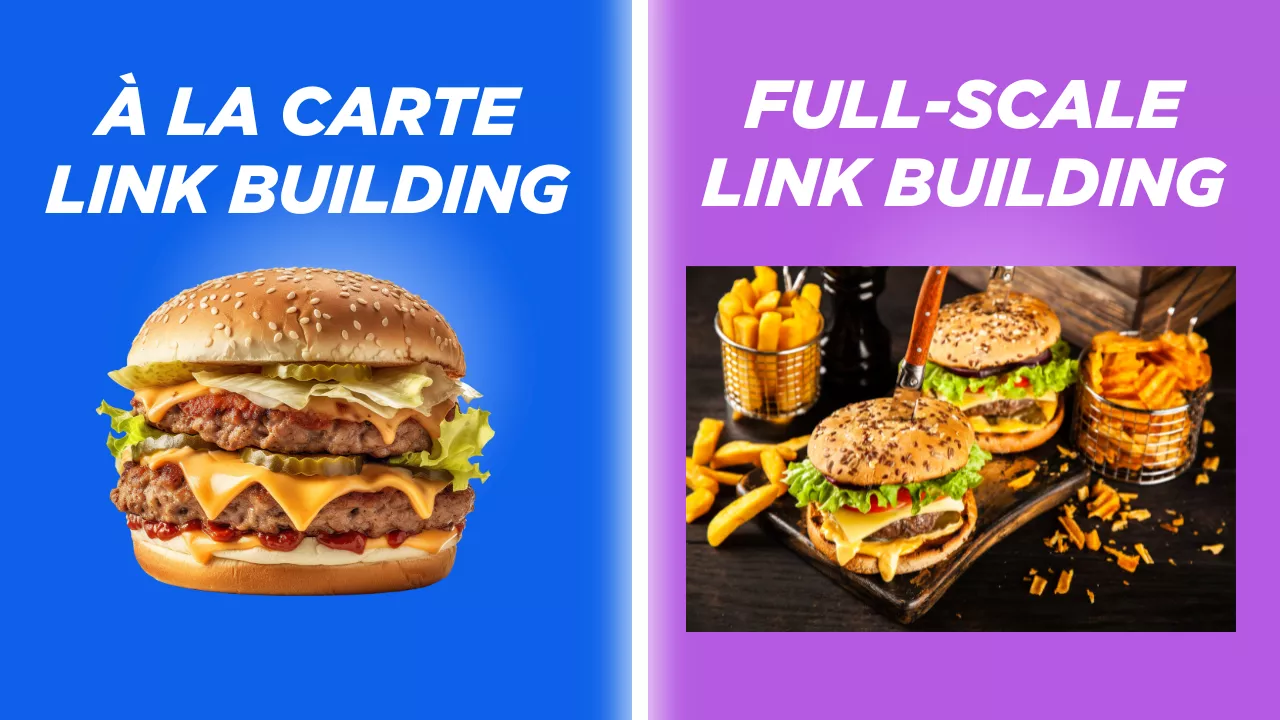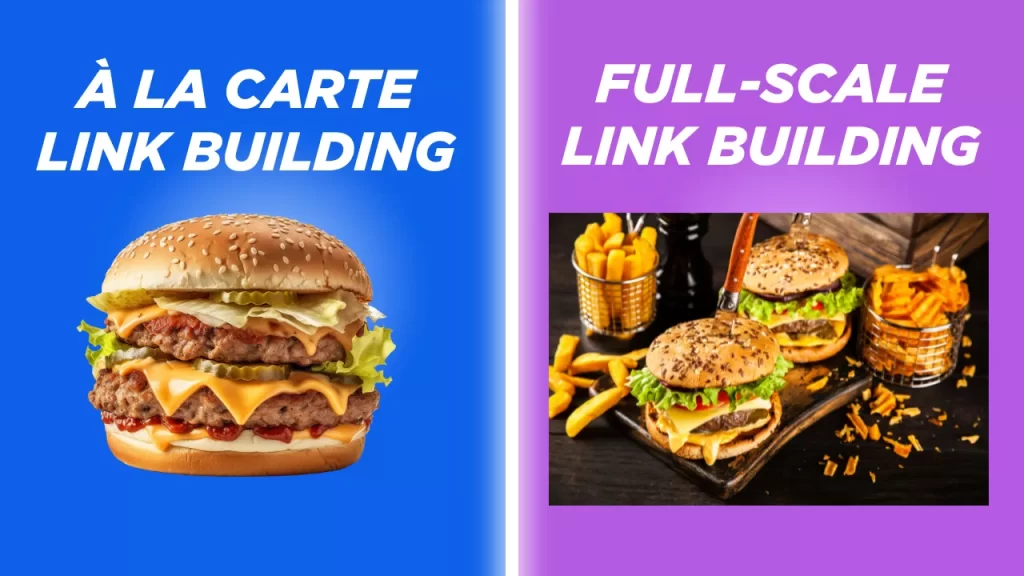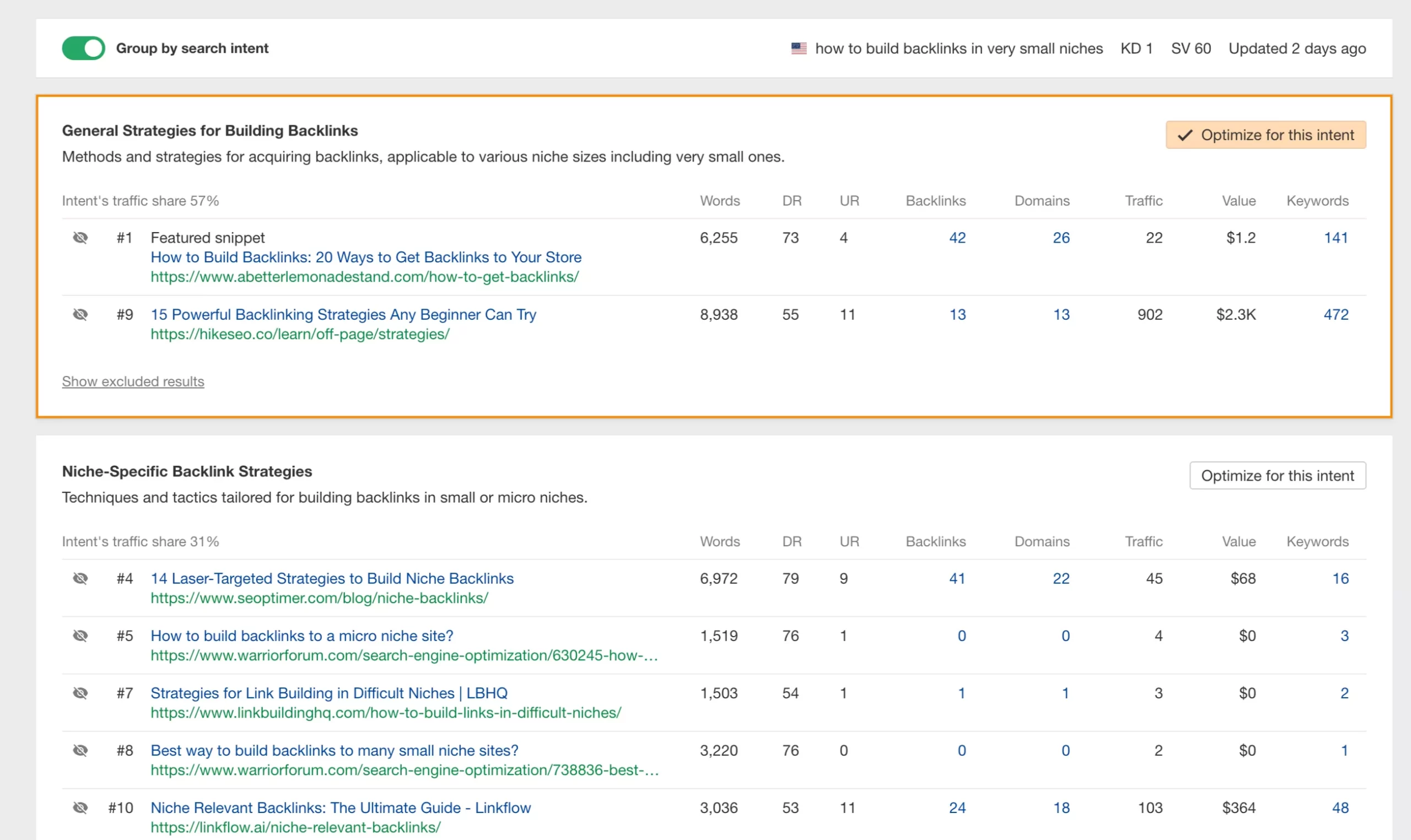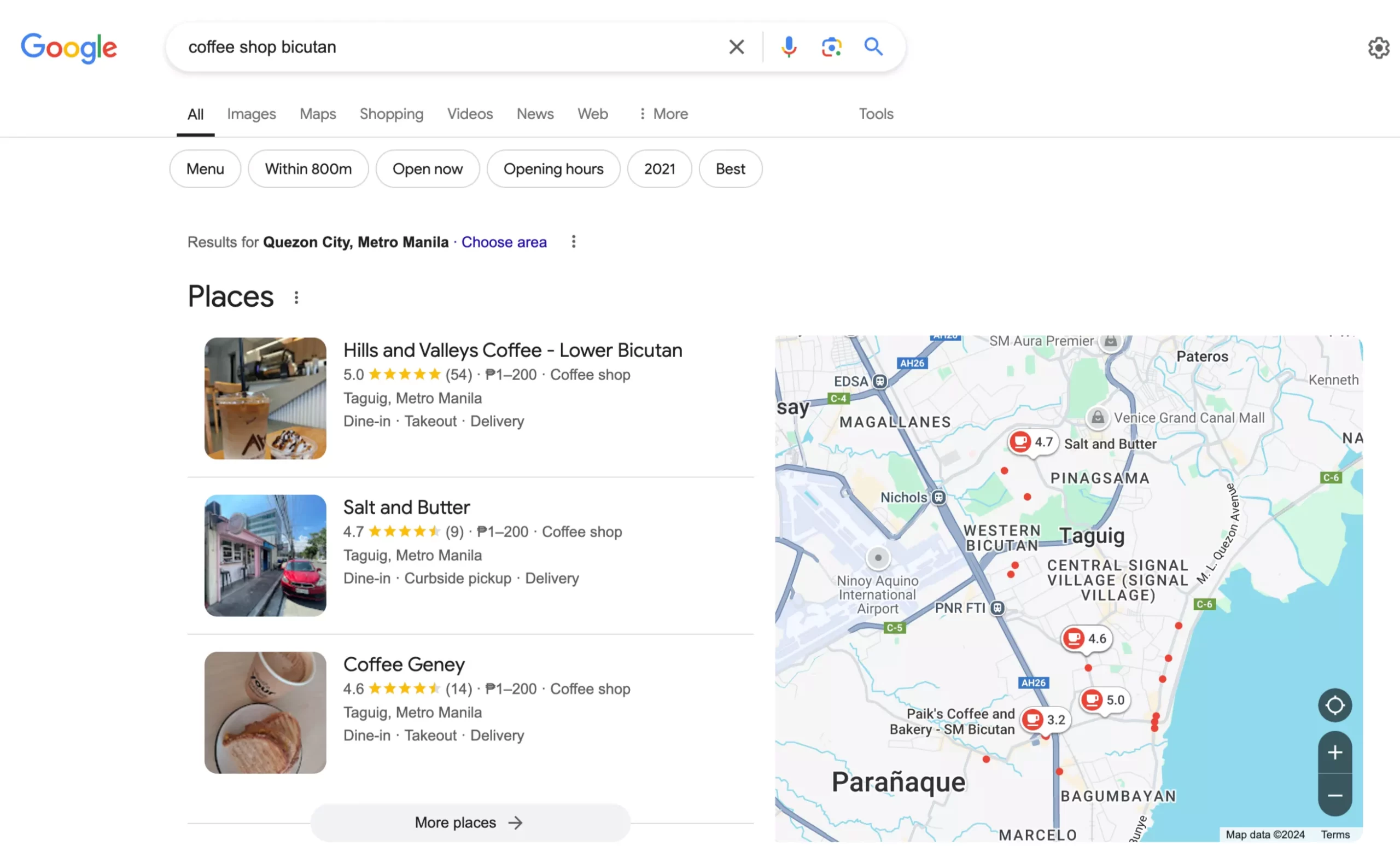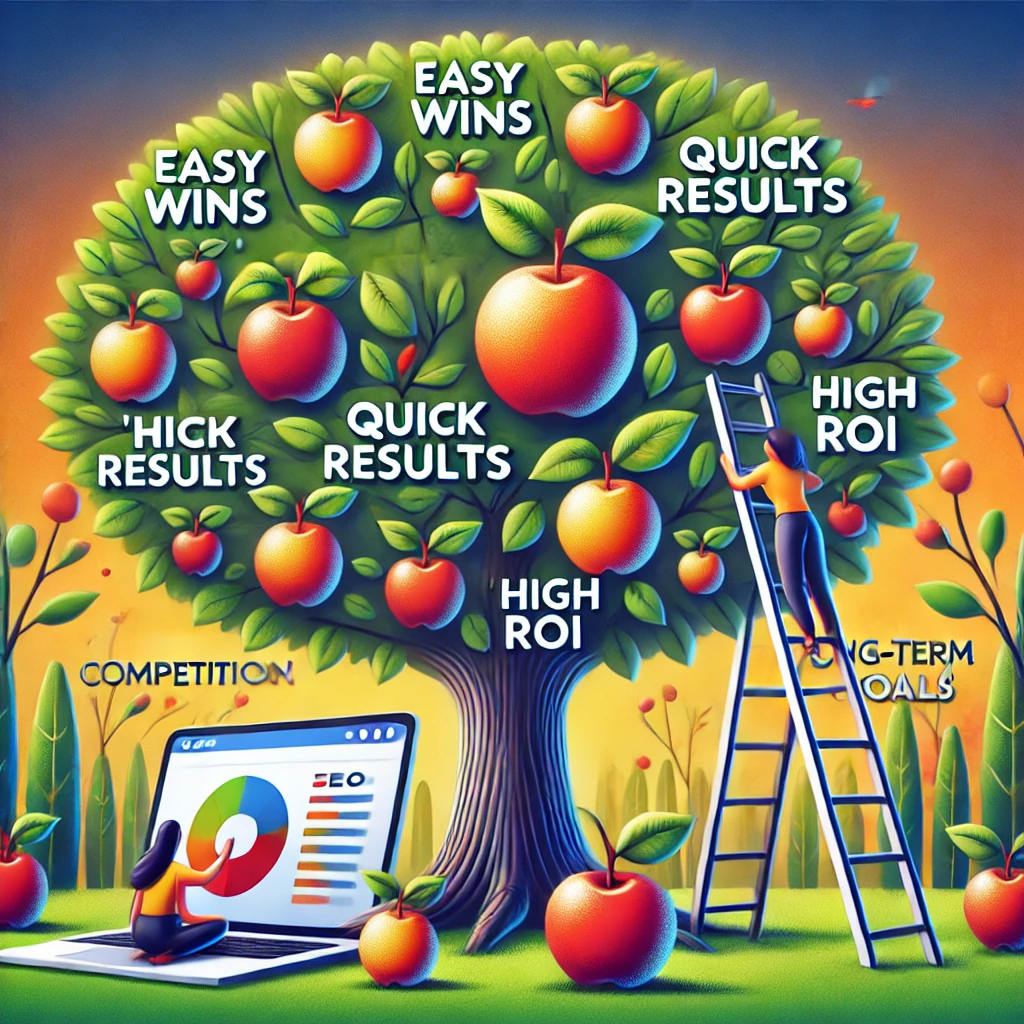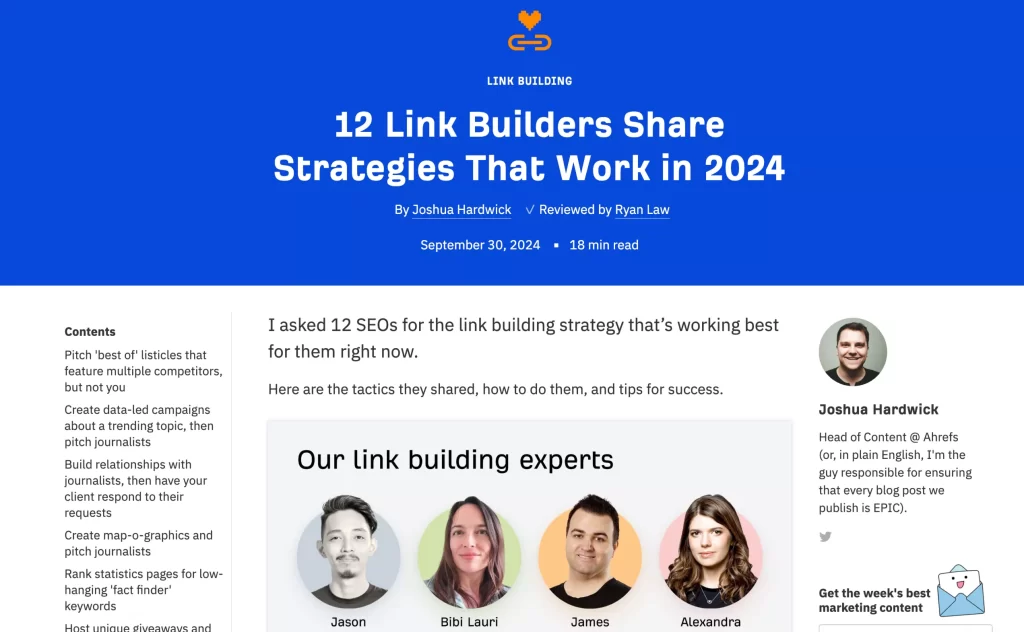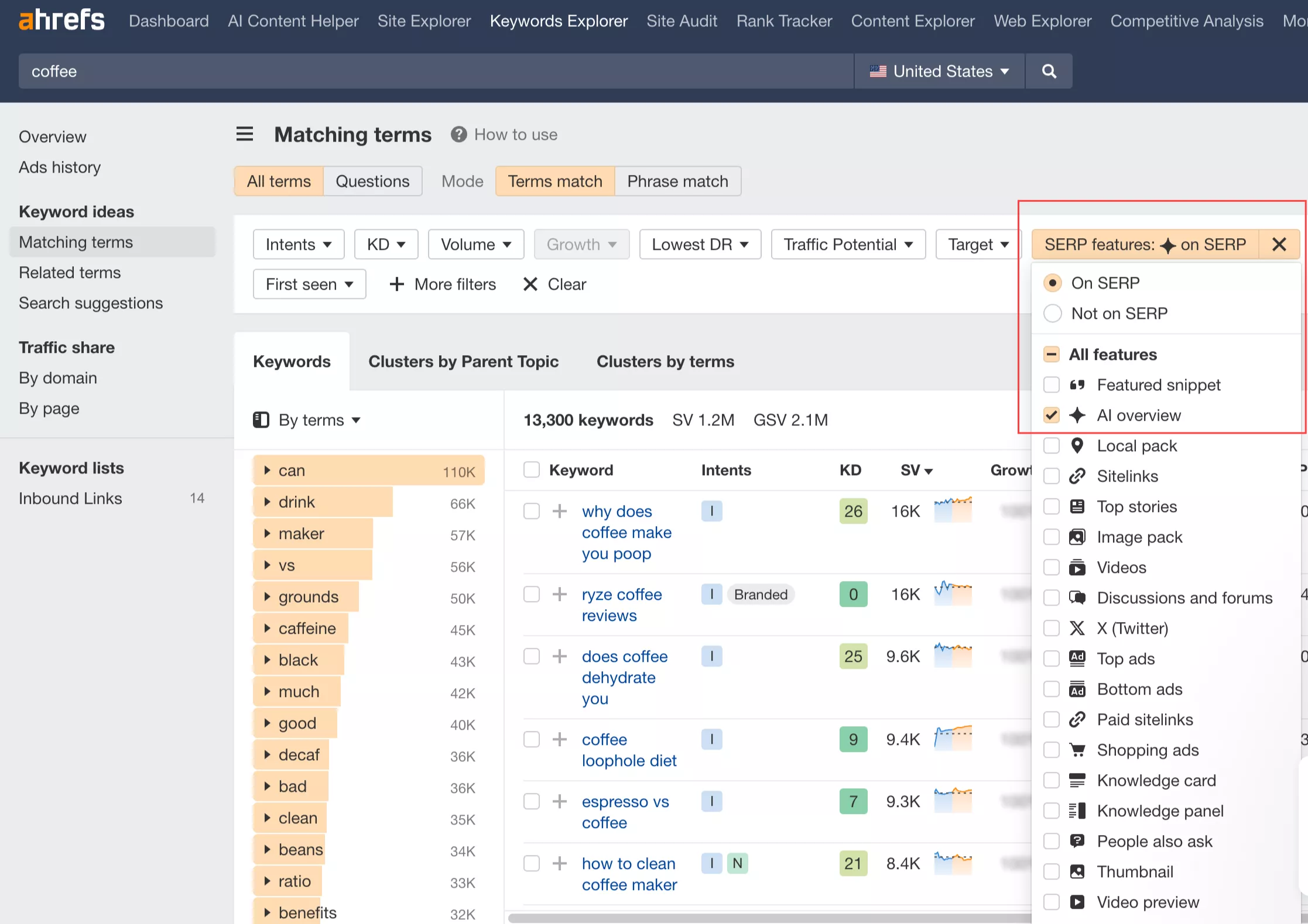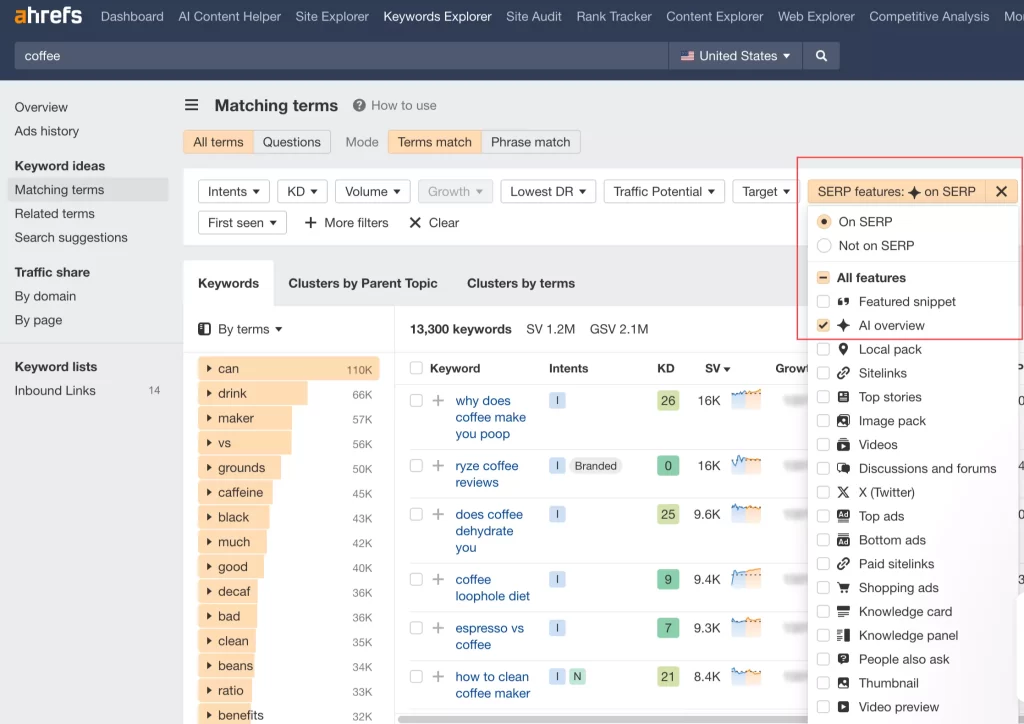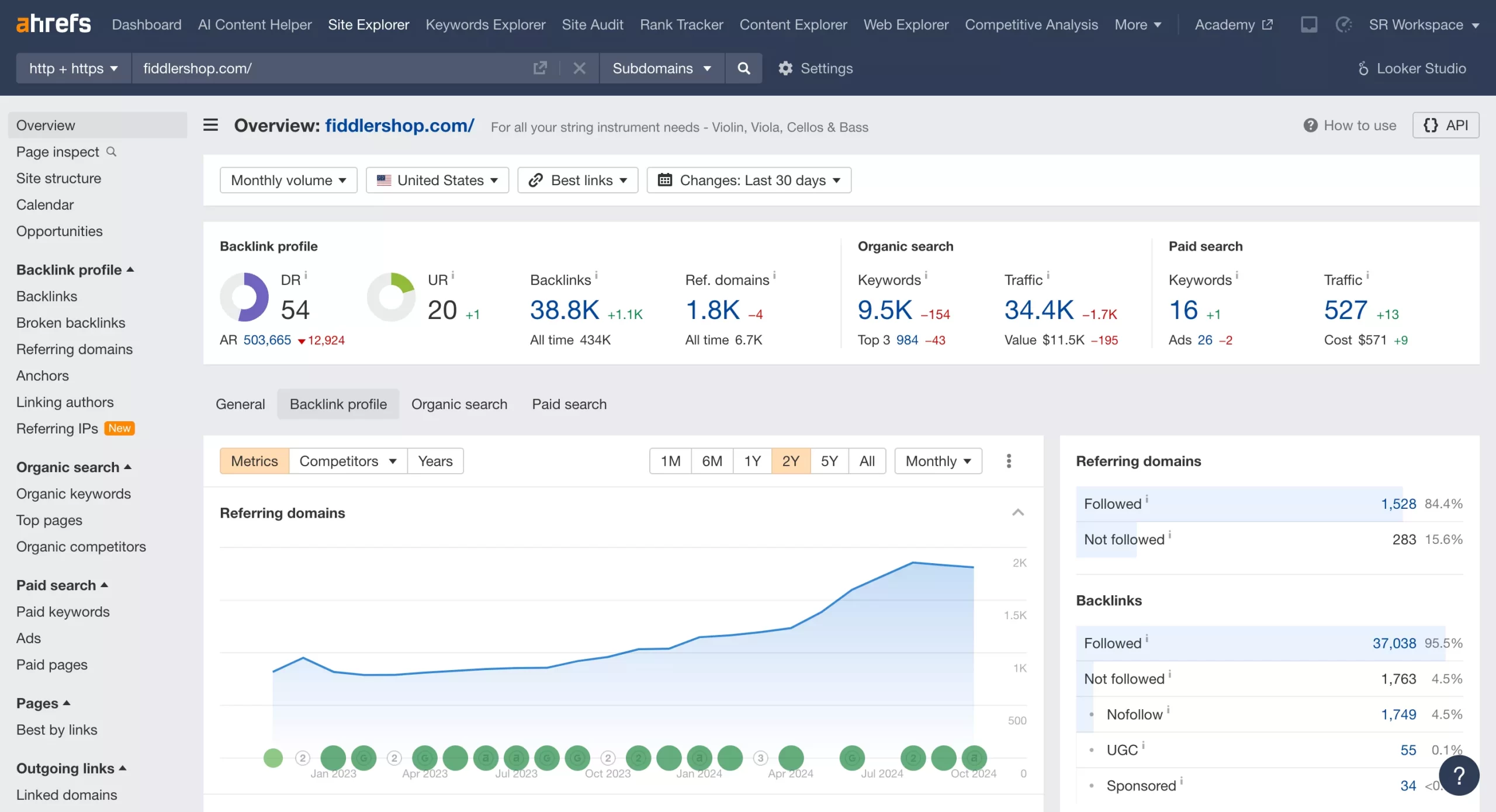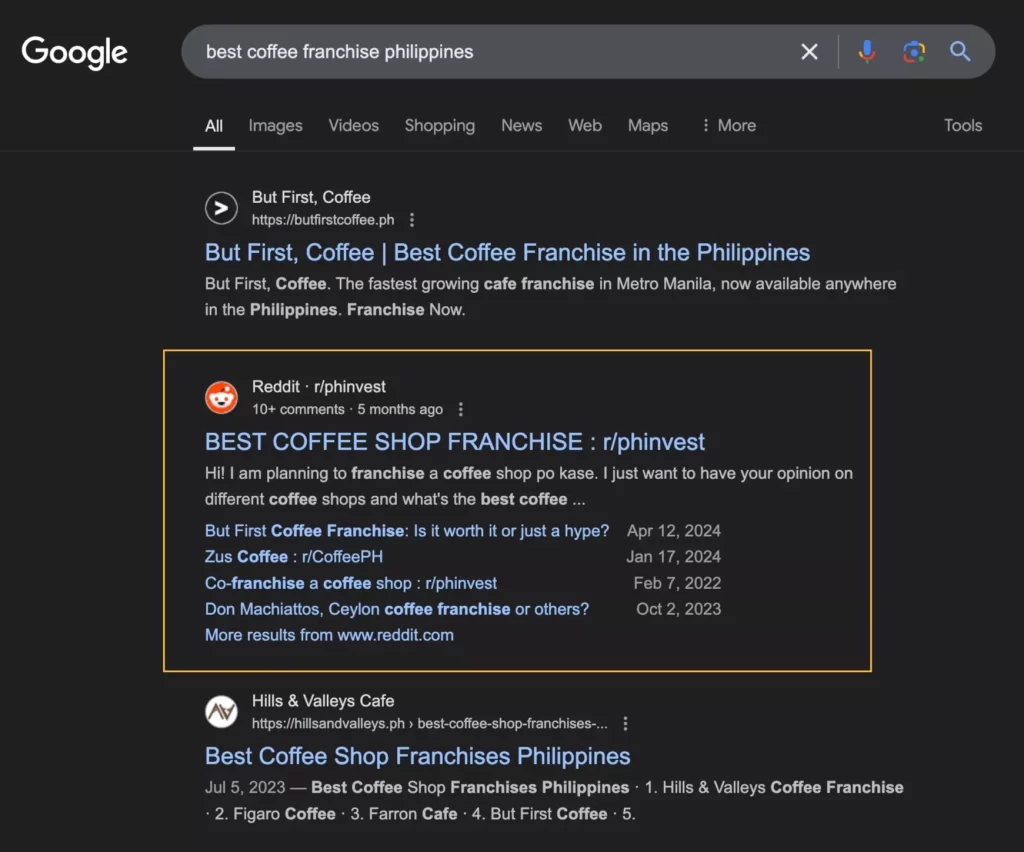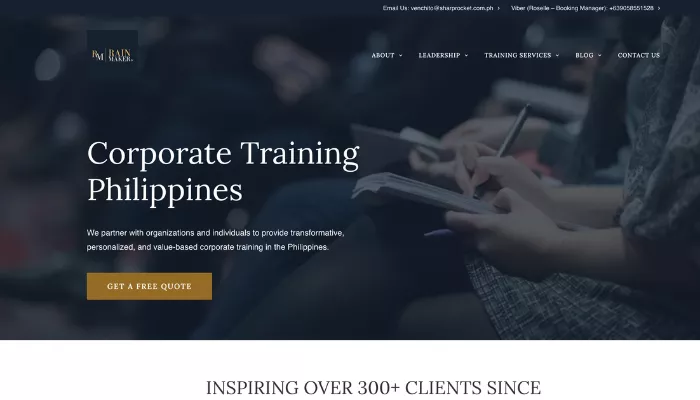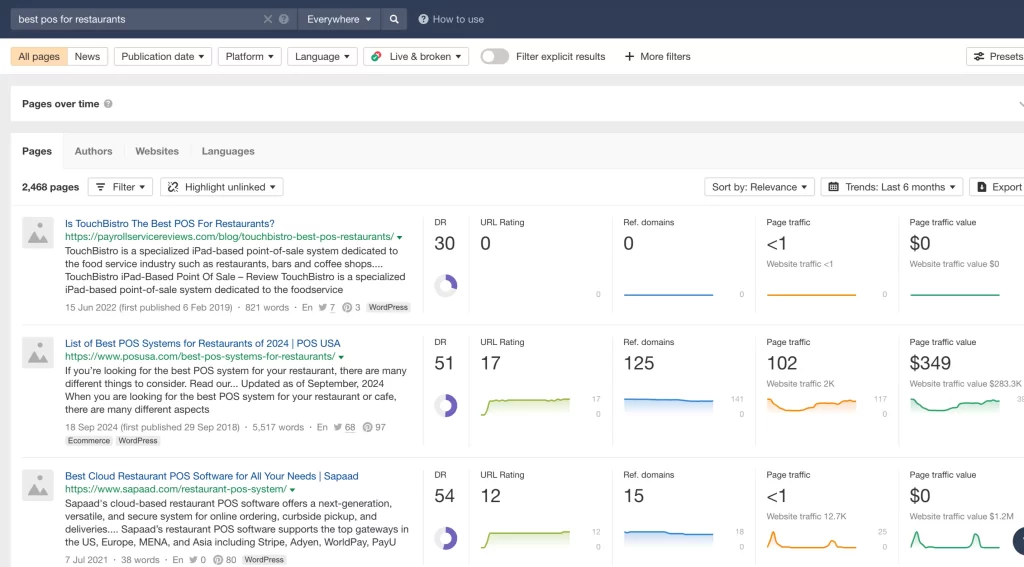Luxury Travel SEO: How to Attract High-Net-Worth Travelers
Unlike mainstream travel, luxury travel SEO is uniquely challenging.
The target audience caters to a small, specific group —high-net-worth individuals (HNWIs) and ultra-high-net-worth individuals (UHNWIs) with distinct search behaviors who expect highly personalized curated experiences. In other words, it requires finesse to satisfy them with content.
To make things even more challenging, many keywords you need to rank for are contested by international giants like TripAdvisor, Expedia, Booking.com, travel agent sites, and other serious competitors.
Topping it off, publishing generic travel content is a sure-fail to engage your audience, given the discerning tastes of HNWIs.
We’ve worked with a few luxury travel SEO brands, and in this guide, we’ll share tips on how you can navigate challenges associated with this niche industry if you have a client of yours.
1. Target Zero to Low Search Volume but Highly Conversion-Intent Keywords
Luxury travel-related keywords typically have low search volumes, but their profitability makes them worth pursuing.
For instance, phrases like:
- “Private yacht charters Maldives”
- “Luxury safari lodges in Africa”
- “Exclusive ski resorts in Switzerland”
Those keywords are particular but command strong purchase intent. While it may not be a “best practice SEO” to pursue low-search-volume keywords, let alone zero-volume ones, if you know your customers are searching for them, it’s time to incorporate this into your keyword research strategy.
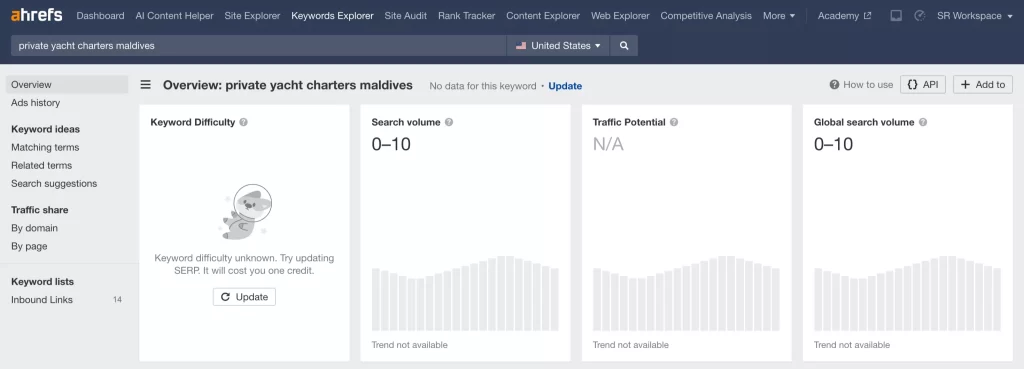
For example, you can see in the above image that “private yacht charter Maldives” only has an estimated 0 to 10 search volume, but it is worth ranking given its conversion potential. A quick look at the ranking pages reveals that some pages rank as competitors' homepages, with few curated lists of private charts and product listing pages.
If your site can create a product listing page targeting these long-tail keywords (much like what you do for an eCommerce SEO) or a roundup page, you’ll have chances of ranking for this type of keyword.
If you’re doing client SEO, starting from a medium-to-high authority is typical when working with luxury travel SEO - as they have acquired passive links and built substantial brand share in their own rights.
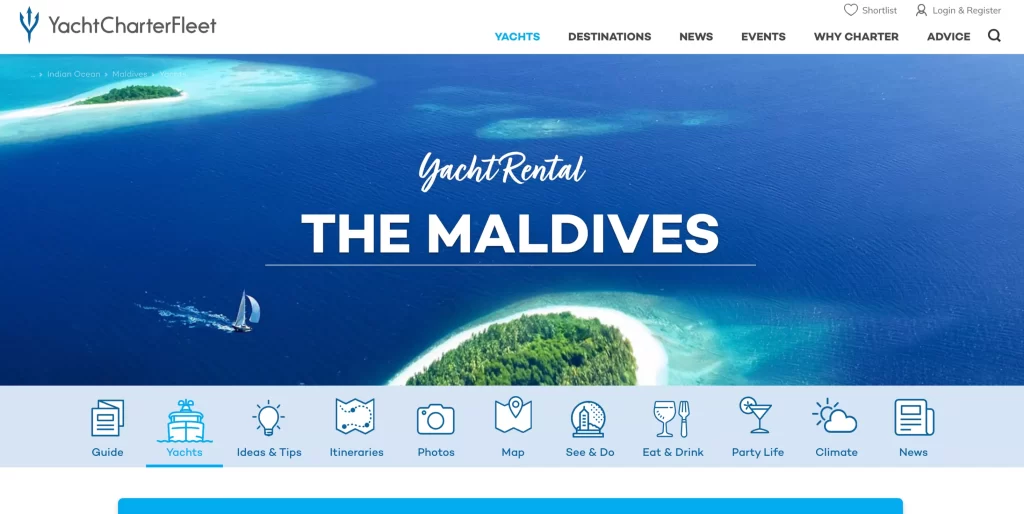
Given that, it’s a good thing to maximize their existing domain authority to quickly rank for long-tail keywords and gain momentum through multiple ranking for variant keywords with topic clusters and dedicated landing pages.
2. Create Content That Resonates with the Luxury Market
Content marketing for luxury travel SEO starts with aligning the brand voice, style, and tone with every content asset you create. You can’t simply create content assets that don’t speak your brand’s language, as this will not represent your client well.
Invest first in understanding your client's business — this will be a cornerstone for navigating the content marketing journey.
Here are examples of content themes you could generate on your site:
- Behind-the-scenes access to luxury destinations, such as private islands or hidden vineyards.
- Profiles of premium services, like Michelin-starred dining or bespoke spa treatments (these could also yield organic traffic if they have dedicated pages to rank for each keyphrase).
- Tailored itineraries for unique travel preferences, such as family-friendly safaris or romantic getaways.
A few good examples are “5 Private Islands in the Caribbean You Can Rent” and “The Travellers’ Guide to Exclusive Culinary Tours in Tuscany.”
Publishing these thematic content helps bring potential customers closer to their purchasing decisions. Balance this informational type well to create a content moat in your niche.
Rank for “Best Luxury [X]” Lists
The pages on the best X lists are among the rankable content types. They not only assist potential customers who are still deciding what solution provider to choose but can also help reveal differentiated products/services in a certain category, helping customers make the ideal choice.
Examples of this are “best luxury hotels in Paris” and “top private safari lodges in Kenya”.
Organically, you should be included in these “best luxury X” lists if you’re the best in a particular area of expertise. If you’re good at what you do, publishers will likely see you best fit to include in their roundups. Usually, it's easy for a niche like luxury travel to determine the best based on reviews, recognitions, and award-giving bodies. Conversely, creating your own roundups is a way to show up in those lists.
Remember that people searching for the best luxury X lists are likely seeking unbiased, curated recommendations. Not beating your competitors is ethical and helps you build brand authority. It also makes your product/service more premium than others on the list, and it’s a matter of how well you showcase the actual value of your offering.
Ranking the best luxury lists can help prepare your site to show up in AI search engines like Gemini and ChatGPT, as most luxury travelers may be using AI search to get quick answers.
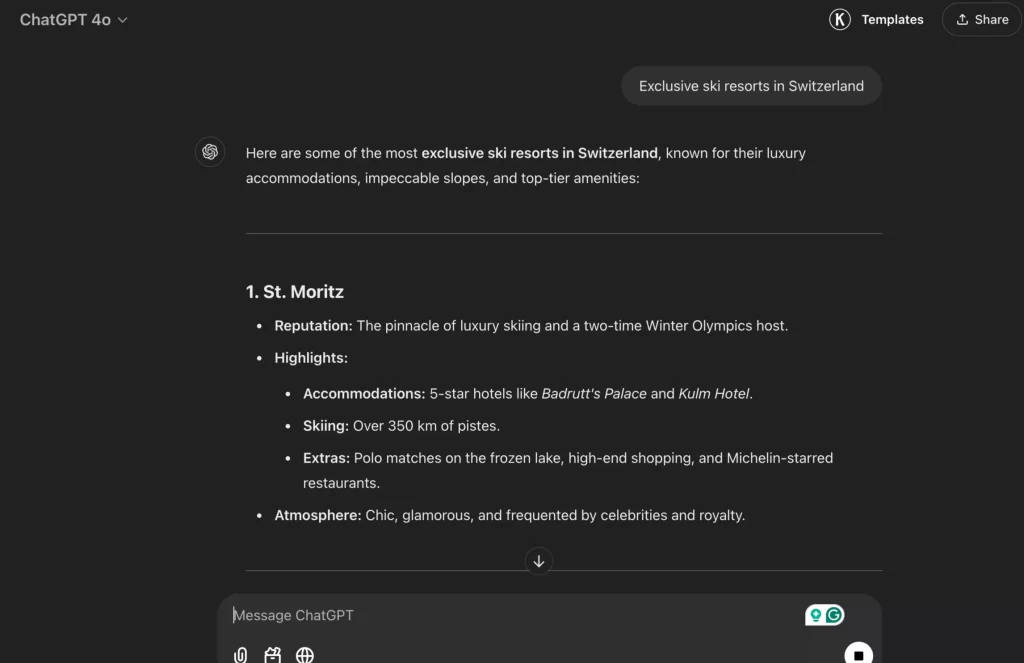
Enhance Copywriting for Affluent Audiences
Copywriting 101 in luxury travel SEO involves addressing customers' pain points, using aspirational language, and providing vivid descriptions. Your copy must serve your HNWI and UHNWI audience.
One way to do that is to highlight exclusivity and prestige (e.g., “Unparalleled privacy and bespoke services designed for your ultimate comfort”). Remember that people at the highest status level want privacy.
In addition, you can input words that evoke sensory imagery (e.g., “Experience the serenity of your private overwater villa with panoramic ocean views”). A more detailed description of what your place looks like or what makes your private charter worth their investment makes it easy for them to see the entire experience (or at least a glimpse).
3. Leverage Enterprise Link Building and Corporate Partnerships
One upside for well-known luxury brands is how easy it is to execute enterprise link building. Being prominent in the offline world makes getting attention (done wisely) easier for creative, linkable assets to attract passive backlinks.
If you’re starting in luxury brand client SEO, use link analysis tools like Ahrefs to examine your site’s backlink profile quickly.
Analyze the pages currently getting the most inbound links and the types of pages linked to (destination pages of the client’s site). This way, you’ll know exactly what’s already working and what’s worth doubling efforts on.
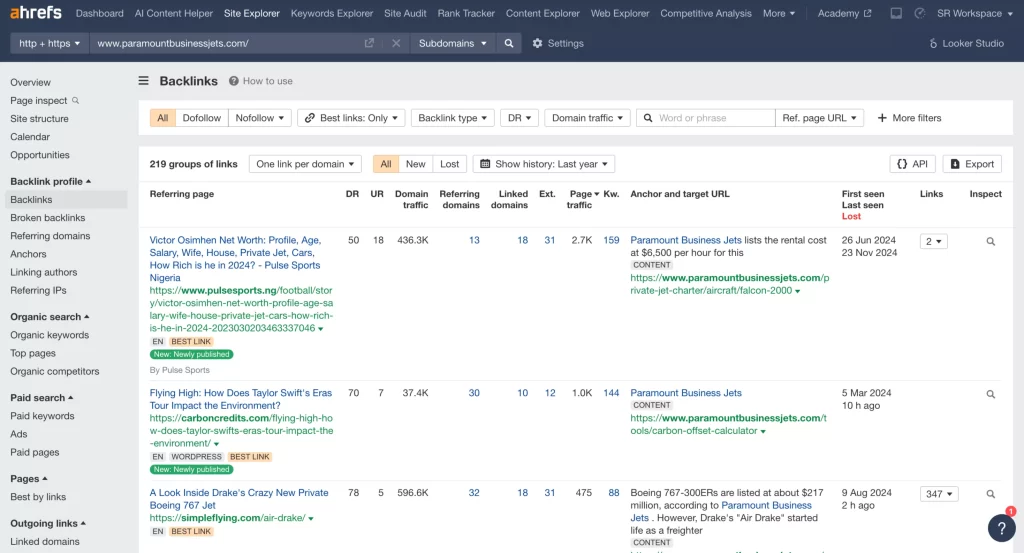
For instance, given the corporate relationships, you’ll find many corporate brands organically linked to your client’s site.
Of the many advantages that luxury companies have, one of my favorites is having strong relationships with powerful, influential, non-competing entities that have monster websites of their own. Leveraging partnerships with them will bring financial breakthroughs and synergy for content marketing and link building. Collaborating on thought leadership campaigns and product placement is a great way to maximize the value of a partnership and enjoy the SEO and branding benefits.
Another way to capture partnership leverage is to write high-utility content pieces for luxury blogs or publications. The social proof accompanied by being a luxury brand (and its association with other entities) makes it easier for your team to pitch publishers (that others in the space don’t get easy access to).
Recognizable Thought Leaders
Thought leaders' advice is constantly sought and rewarded with everything from praise to financial compensation. If you run a luxury travel brand owned by a major enterprise, your company and some of its employees have a good chance of being recognized as thought leaders in your industry.
Leverage thought leadership even more by translating it into content and campaigns to get you more traffic and links. Work closely with product marketing and ask them about hot trends in your business.
Get their thoughts on customer needs and wants. Then, you should be able to list a set of themes and topics that will drive your content and target the right people.
Effective enterprise link builders and content developers can create whitepapers, blog posts, videos, and SlideShare presentations from collaborations between the content team, product marketing teams, product development departments, and your sales force.
Tool Creation
When it comes to linkable assets, we often think of blog posts, infographics, and videos—one of the areas that we need to remember about as a potential link magnet is good functionality. You see, people don’t go online just to find information and to interact with people via social media platforms. We also go online to find solutions to our problems.
One of the easiest ways to provide a solution and, in return, get the right types of backlinks is by providing a tool that users can enjoy on your webpage or download and install right on their devices.
You’ll see several tools in the travel space, such as trip cost estimator, but nothing close to helping high-net-worth clients with luxury travel.
One tool idea that you can make is an interactive tool that allows users to estimate the cost of their dream luxury vacation based on their preferences, such as destination, duration, accommodation level (5-star resorts, private villas, etc.), transportation mode (private jets, first-class flights, yachts), dining preferences (Michelin-starred restaurants, private chefs), and special experiences (hot air balloon rides, safari tours, private island access).
By doing so, you’re creating a unique tool that can earn backlinks your competitors can’t easily replicate with their own link building campaigns.
4. Build High Authority Backlinks with Digital PR
The constraint most link builders and digital PR specialists have is in the story template - what types of stories are aligned to the brand that also resonates highly with top-tier publishers and journalists?
Luxury travel brands have a natural advantage when it comes to digital PR. If you’re working with well-known brands, you must monitor every brand story your company is shelling out to keep building high-authority backlinks to your site.
Here are a few content themes that really work effectively in the digital PR space:
- Experts reveal whether you should [topic]
- The most popular movies to [topic]
- The best [topic] songs
- best/worst/tools [topic]
- [industry] expert explains how often [topic]
- why/why not you should [topic]
Let’s have quick examples. For a private jet brand, here are some ideas we can generate:
- Experts reveal whether you should charter or buy a private jet
- The most popular movies to watch while flying on a private jet
- The best travel songs to play on your private jet
- The worst myths about private jets (debunked by experts)
- Aviation expert explains how often private jets are the best option for business
- Why you should choose a private jet over first-class flights
- The most popular action movies featuring private jets
- The best private jet apps to plan your next trip
- Luxury travel expert explains how often you should fly private instead of commercial
- Why not all private jets are created equal (what you need to know before booking)
- The best luxury lifestyle songs for a private jet playlist
- Sustainability expert explains how often private jets impact the environment
- The most popular movies to inspire your private jet dreams
- Top tools to enhance your private jet experience
- Why you should rent a private jet for special events
- Experts reveal whether private jets are more eco-friendly than commercial flights
- The list goes on, but remember, it all boils down to executing the idea of pitching journalists your content or story.
This ideation tool can help you generate insights for your digital PR campaign.
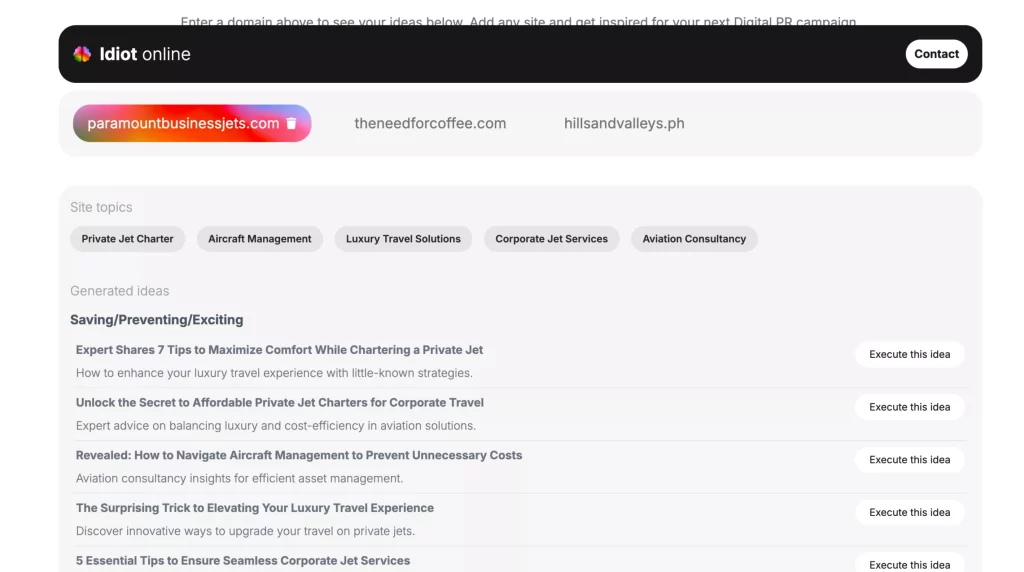
Simply plug in your domain, and it will help generate a list of creative ideas you can start working on best on what you think is relevant and best fit.
Reactive PR with Celebrities
A good majority of affluent clients in the travel niche are celebrities. While confidentiality is essential in a digital PR campaign, you can monitor and react to celebrity news through expert commentaries—we call, “reactive PR”.
Reactive PR, often called newsjacking, is a public relations strategy in which brands or businesses respond in real-time to trending news, events, or public discussions to gain media attention and engage their audience. This approach can immensely speed up the process of obtaining DR or DA90 backlinks, as most publishers are hungry for news stories and additional commentaries during this stage.
However, reactive PR requires speed and creativity. So, you must keep up with the latest news but remain relevant to your client’s brand.
5. Create a Seamless Website UX/UI
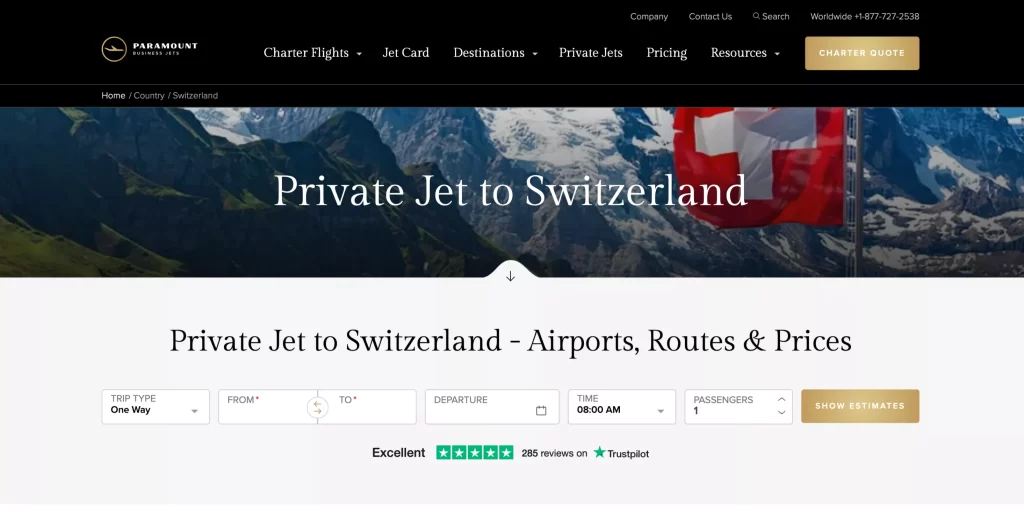
Even the best SEO strategies will only succeed if your website’s user experience meets the expectations of luxury travelers. A poorly designed site undermines the perception of quality and exclusivity.
This is a no-brainer for the luxury travel industry. You want to invest in premium web design that reflects your brand’s luxury ethos through a clean, sophisticated layout, intuitive navigation, high-quality visuals, and interactive features like 360-degree virtual tours.
Your website should be mobile-friendly, as many affluent travelers conduct searches on mobile devices.
6. Hyper-Local Campaigns for Easy Link Building
The local scene in link building is more advantageous in acquiring low-hanging fruits in SEO. The more local your approach to digital PR and other link building strategies, the easier and higher likelihood you’ll increase your site’s ability to get links.
Given that local publications often have less competition for stories and are more likely to cover niche angles, you can tap into different local cities depending on the locations of your target audience.
For example, a “Top 10 Most Luxurious Airports in Europe” campaign can be pitched to local newspapers in cities that house these airports, or a “Best Luxury Cycling Routes in France” could attract interest from French regional travel sites. This approach brings more upsides if you’re a global luxury travel brand, as you can target different cities in different countries (now, having multiple angles you can make for a single story).
You can also check out this guide on how to build backlinks in a very small niche.
Luxury Demands Finesse—So Does Your SEO
You are not dealing with a typical customer, so your luxury travel SEO should reflect the exclusivity and quality of your brand. Accompanying these results are your keyword rankings and higher search conversions.
Implementing these strategies, you will do what your brand deserves and what you hope to be known for in the travel space.
SEO Retainer Guide: À La Carte or Full-Scale Link Building?
Do you need SEO every month?
Short answer: Yes.
Long Answer: You need consistent SEO work required to adapt and sustain results. And even if you’ve maintained top search rankings for your head terms, there’s still room for growth for any type of business.
SEO retainer is a service agreement where an agency or consultant provides ongoing SEO support and implementation for a monthly fee.
I’ve seen marketing agencies and companies realize more today than before how continuous work is necessary to sustain SEO results, given the ever-changing search landscape, surprising core and other Google algorithm updates, and new players in every industry trying to dominate Google’s SERPs.
Of course, getting buy-in from in-house stakeholders (Head of SEO, marketing manager, and VPs of Marketing) requires arm chests and tools of persuasion, managing expectations, and in-depth expertise of your offer.
But compared to years ago, selling and hiring agencies for monthly SEO retainers who can do the job is much simpler.
In this guide, I won’t cover full-packaged SEO retainers, which includes technical SEO, on-page SEO audit, content asset creation, analysis, and reporting. Still, I’ll go deep into one essential SEO retainer facet: link building retainers.
The Value of Link Building Retainers
You’ve seen this everywhere—link building agencies selling one-time-off packages, a few to a couple of links in a single project, with guarantees of quick results. In a nutshell, it’s like link building - selling pancakes.
While it’s true that there are certain times when link building is needed or when having few links to certain pages boosts their individual rankings, treating link building like quick magic for your website is not a good thing.
For the most part, competitive brands still engage in long-term link building, as they see it not just as another SEO activity but as part of a robust branding campaign.
Viewing link building from a sustainable perspective keeps your focus on creating a flywheel effect on your search traffic as you see incremental (and even exponential) impact on one of your pages and on the total link equity and brand strength of your website.
À La Carte vs. Full Link Building Retainers: What’s Typically Included?
If you’re looking to hire a link building agency or consultant, you’ll probably choose between these two types of link building retainers: à la carte and full link-building retainer.
À La Carte Link Building Services
This type of monthly retainer allows clients to purchase specific link building services or packages at the pace of their needs. It’s usually a one-time or occasional purchase, ideal for businesses with very limited budgets.
If you’re getting à la carte link building service, you should have a particular link quantity and quality in mind—the number of links and predefined metrics for links (e.g., Ahrefs DR30+, Majestic Trust Flow 25..), as well as the type of links, whether it’s a guest post, niche edits, local citations, or a few foundational links.
In this case, the client specifies the pages and target keywords the links should support. The link building agency must provide all this information, and at the end of the timeframe agreed to deliver, it would show up on reports, including the exact link placement for verification.
A very straightforward way to purchase a service. You’ll have full control over the preferences of both the quantity and quality of links you want to build.
However, the downside of an à la carte link building service is the lack of ongoing strategy and optimization. As you’ll only get plain deliverables of links, you can’t expect the link building agency you’re partnering with to provide you with the next optimization efforts. In other words, you only get the execution part, not the strategy service.
This requires you to fully strategize the more granular details of your link building campaign, aligning it with your entire SEO campaign before hiring an à la carte link building agency.
I won’t recommend this type of service if you don’t have a solid running SEO team and an SEO strategy at the start. You may be building tons of links, but if they don’t align and integrate well with your top-eye-view SEO strategy, they will only make a minimal impact.
Another drawback of getting à la carte link building services is the minimal support you can expect from an agency or consultant. It’s a piece-by-piece type of work where service providers hand over a list of live links, and that’s pretty much what you can expect from them.
Full Link Building Retainers
Full-scale link building retainers involve comprehensive strategy development and execution to manage the entire link acquisition process.
If you’ve been doing link building, you know that it involves link strategy development, link research (link prospecting), link qualification and approval, content creation, and outreach campaign development —all of which are critical to the success of the backlink campaign.
Partnering with full link building retainers isn’t cheap. After all, the immense value you’ll get is hands-off tasks from strategy to execution, which require hours of time and mind work to execute correctly.
This type of link building retainer is more appealing than à la carte retainers, as it includes a free consultation in addition to the link building package itself.
For example, SharpRocket is a full-scale link building retainer covering everything from strategy development to relationship management. In detail, we start with competitor backlink analysis and link gap analysis to see how many quality links we have to build to dominate the top 3 spots for your target keywords (assuming we already have target pages to build links to).
Then, we determine the appropriate link types for the client’s business. If it’s a local client, we focus on local links and citations. If it’s a B2B SaaS, we focus on tech and other vertically related links, publishing, and news sites.
Other agencies build generic, one-size-fits-all links to all their clients - which diminishes the link value. Remember that certain link types have been working effectively for the ranking sites. You just need to figure out what those are and how to incorporate them into your link building campaign.
You can check out our link building services to learn more about how full-scale link building services work.
The best thing about hiring full-scale link building retainers is the trust you can build upon the agency’s expertise and processes. From their years (even decades) of SEO experience, they’ve dealt with different industries and types of clients, and they could identify similar patterns that could work for your website - customizing the entire strategy and execution so you can gain top-of-the-bar results.
Hiring a full-scale link building agency is beneficial from both financial and relationship perspectives for big agencies and enterprise link building campaigns. Given that it takes 6 or 12 months to onboard a new service provider, having someone continue doing the link building work could adjust to the agile movements of the SEO campaign.
How to Choose the Right SEO (Link Building) Retainer
1. Evaluate Their Backlink Profile
It’s easy for an agency to say they’re building high-quality backlinks, but unless you see what kind of quality they’re talking about, you shouldn’t rely on their lip service.
One way to examine this even before inquiring about their services is to look at their agency’s site backlink profile.
If you have link analysis tools like Ahrefs, simply plug in their agency website and have a quick assessment of their current link profile. See what types of backlinks they’re building. Are the links mostly organic or paid? Do they build editorial or contextual backlinks? From which industry do they focus on link acquisition? Is it relevant to the market?
Obviously, this isn’t 100% perfect criteria for determining whether they’re the right fit. But if they know how to grow their own SEO agency by building more quality links to their agency website, it definitely attests to how well they can take care of you as their prospective client - for the least part.
2. Ask For Samples of Links and Social Proofs
I’ve observed this a common request from prospective clients in our UK link-building agency—they usually request samples of links and clients we’ve worked with (ones we can disclose to the public).
The reason is plain simple. If they can provide you with the exact link placements they acquired for a specific client, you could tangibly assess their link types and quality. And it should be based on either topical relevance, link metrics (e.g., Ahrefs DR30+), trust, and thematic flow.
It would be a plus, of course, if they could show you case studies from clients within your industry, as the types of links they would typically tackle would be similar to yours.
When it comes to social proof, be careful. Some case studies of ther agencies are copy-cat or plain screenshots of organic traffic reports using SEO tools like Ahrefs or SEMRush. They don’t mind getting other agencies’ social proof.
3. Understand How They Measure Results
Like any other SEO campaign (and any business initiative), you should measure results. Evaluating progress (or regress) helps marketers improve their work through adjustments.
When you meet with your prospective SEO link building retainer, confirm they could align their work with your SEO and business objectives. Ask, what types of metrics do they look at? Will they provide performance reports?
These questions help you understand their exact deliverables and approach to link building. If it’s all about links to rankings without consideration of how your brand will be perceived in the market, think through it.
4. Ask Who Will Handle Your Account
It’s a nightmare for companies to see SEO agencies today only working directly with account managers. That’s not to say it’s not a good communication model and way of collaboration for both parties.
However, if you can speak and work directly with both an account manager and SEO strategies or are fortunate enough to even talk to the CEO who does the strategy work, who will relay the progress of your campaign, you will have more confidence and trust in the results you can expect from them.
5. Relay Confidentiality (If Applicable)
If you work for big corporations with strict branding and legal requirements, remember to tell your partnered link building agency about these. They should be aware of any confidentiality concerns before the link building campaign even starts.
This way, you avoid running issues in sharing data that shouldn’t be disclosed as the campaign runs.
Make The Right Choice For SEO (Link Building) Retainers
These tips will increase your chances of partnering with the correct link building agency or consultant for monthly link building retainers. As every investment needs to see ROI, deciding on your non-negotiables is critical when picking the right outsourcing firm for your business.
How To Build Backlinks In Very Small Niches
One of the challenging parts of link building is creating a list of targeted opportunities where you’ll have chances of getting links.
This is easy for industries where you can quickly think of audiences to target. However, you may find it very challenging for small niches, such as safety training manuals for niche construction tools and custom gaskets for commercial refrigeration.
In this guide, I’ll show you practical ways to think outside the box so you can learn how to build backlinks in very small niches.
1. Serve More Linkable Audiences
When building backlinks, it’s a common practice to ask what topics you should write about for other sites so they can link to yours. While that’s important, I recommend you start with audience research first.
Think of the audience you want to serve as they’ll also give you links—in SEO lingo, we call them “linkable audiences.”
What Are Linkable Audiences?
Linkable audiences are people likely to share or link to content that resonates with their interests or values. These audience groups include educators, researchers, and web curators.
Their day-to-day work involves maintaining the website, mainly updating their resources or links pages with new links. So, doing SEO outreach to these folks doesn’t require much asking but instead sharing your newly published content that matches their audience's interests and needs.
This approach removes the friction of constantly following up with audiences who won’t necessarily link to new content anyway. They know what to do once you send them new resource links because they, by nature of work, link to other sites.
Here’s a list of highly linkable audiences.
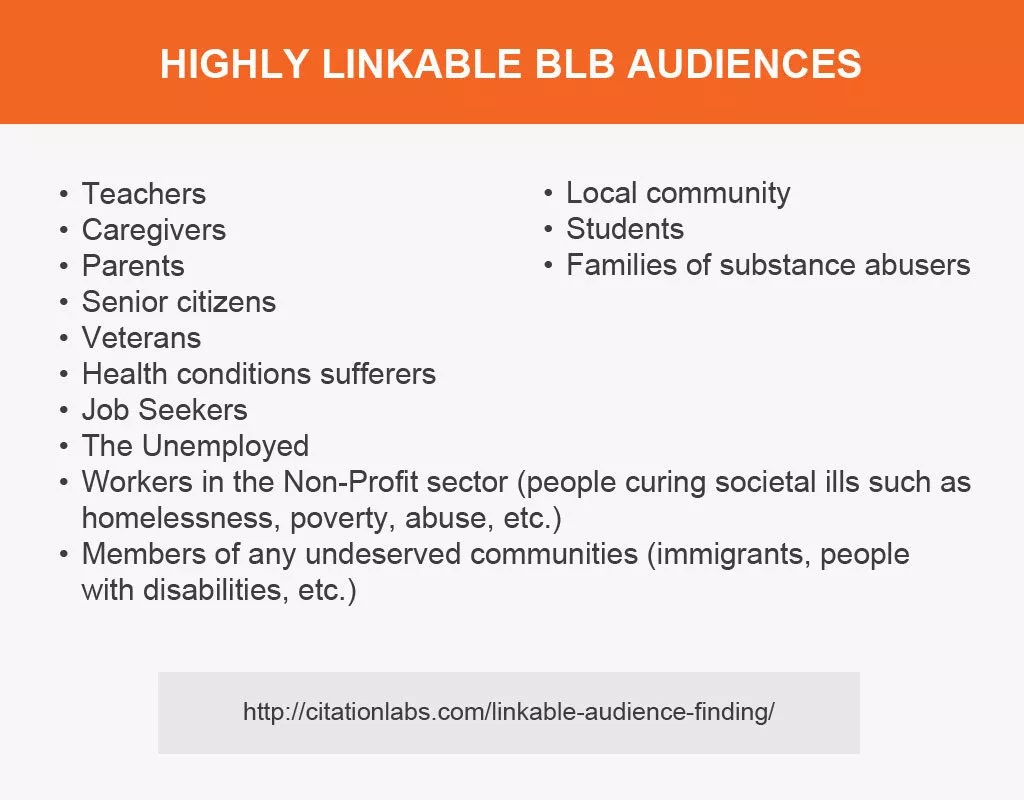
Find connections between your site’s content theme and these linkable audiences. For instance, in my sleeping blog before, I’ve published a couple of guides that target three of these linkable audiences:
- The Ultimate Parent’s Guide to Helping Kids Sleep Better
- PTSD Sleep Solutions: A Practical Guide to Restful Nights
- Veterans' Restful Nights: A Comprehensive Guide to Better Sleep
You can also use ChatGPT to generate topic ideas by connecting your brand’s thematic relevance and these linkable audiences.
Choose content ideas that make sense to your site and could be expertly written based on your available resources (in-house content team, available data, etc..).
2. Leverage Reverse Outreach
Reverse outreach is a link building strategy of creating content that naturally attracts links by getting in front of bloggers and publishers. Instead of contacting other sites for links, you draw them to your site by ranking for highly referential or research keywords.
This is one way to acquire links for very small niches without entirely relying on manual outreach.
Start reverse outreach by developing resources that publishers and bloggers in your industry value. Examples of resources you can create are:
- Industry reports (data)
- Statistics
- Calculator
- Case studies or research papers
You could expand your reach beyond the limited topics of your site. Use Ahrefs’ Content Explorer to find topics and existing linkable assets that highly rank for “research keywords”. Here are a few examples:
- [Your niche/topic] industry statistics 2024
- Latest trends and data in [your niche/topic]
- Comprehensive [niche/topic] market report
- [Niche/topic] growth and projections statistics
- Historical data and insights on [specific aspect of niche]
People who use these search queries are likely during the research stage of their content creation process. And if they find one of your ranking content valuable, they’ll include it as one of their references/resources through links.
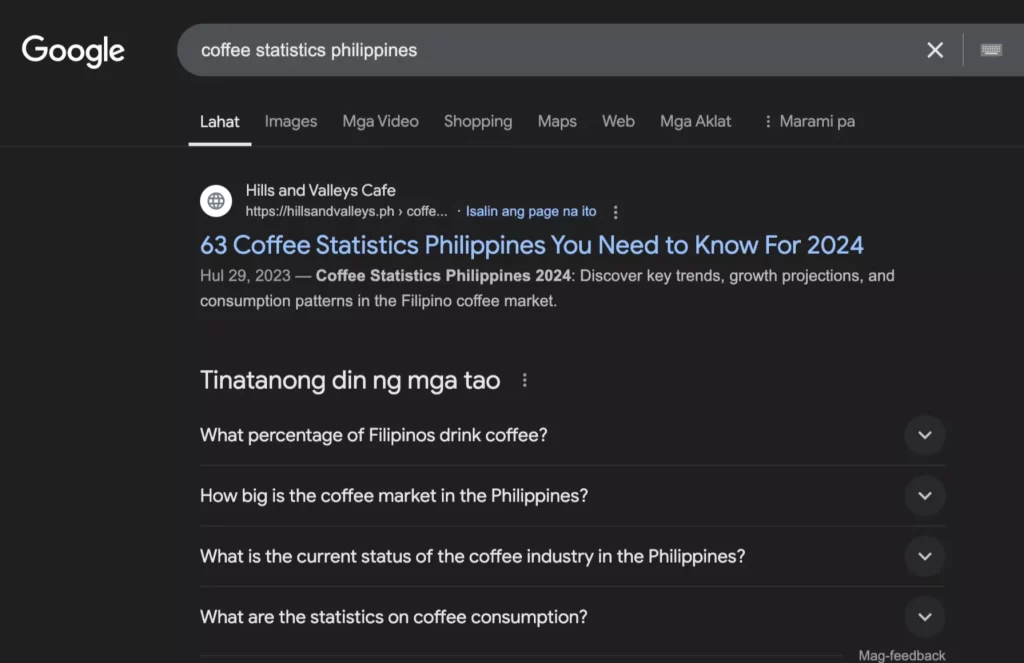
Pro Tip: Look for new linkable content published by competitors or big industry publishers. This could inspire you to create more content for your blog.
3. Capitalize On Your In-house Experts
If you create content similar to the other ranking pages, you create unoriginal content.
Adding a component of first-hand experiences to your linkable asset brings unique perspectives and expands the body of knowledge already available on the web.
To publish more interesting content on your blog, you can interview and collaborate with your in-house experts and potentially other publishers from other sites. Their insights can position your content as authoritative and have higher information gain, increasing the likelihood of backlinks.
You can also leverage expertise through a digital PR campaign.
One new HARO-like platform is Pressflow, which helps connect experts and thought leaders with journalists and publishers looking for credible sources.
When you subscribe to Pressflow, you’ll be notified of the latest requests for insights and quotes. Browse for topics your team of in-house experts (or collaborated leaders) can contribute to, and send your thoughts as soon as you can (remember: time is your greatest ally in digital PR).
For more actionable tips, you can check out my guide on digital PR best practices.
4. Get Event Links Through Sponsorships and Partnerships
One underutilized link building strategy is event link building.
Getting backlinks through sponsoring events and partnering with organizers has a high relevance score, especially in a hyperlocal context, where you’re sponsoring events in local organizations.
Find local events within the industry, and see if they have dedicated event pages on their sites where you can get embedded or text links.
Collaborate on their community initiatives by incentivizing through monetary or non-monetary means, supporting, or event-hosting workshops or meetups.
Many small niches have local business groups or associations, as it’s one way for them to solidify their work and expand business connections. These relationship-building activities allow you to get link opportunities without the usual link begging.
5. Use AI Tools for Content Ideation
One of the major challenges in creating linkable content for small niches is getting new insights and topics that are still on-brand.
You can use AI tools like ChatGPT or the recent Ahrefs feature, “AI Content Helper”, to flesh out new insights and sections you can add to your content.
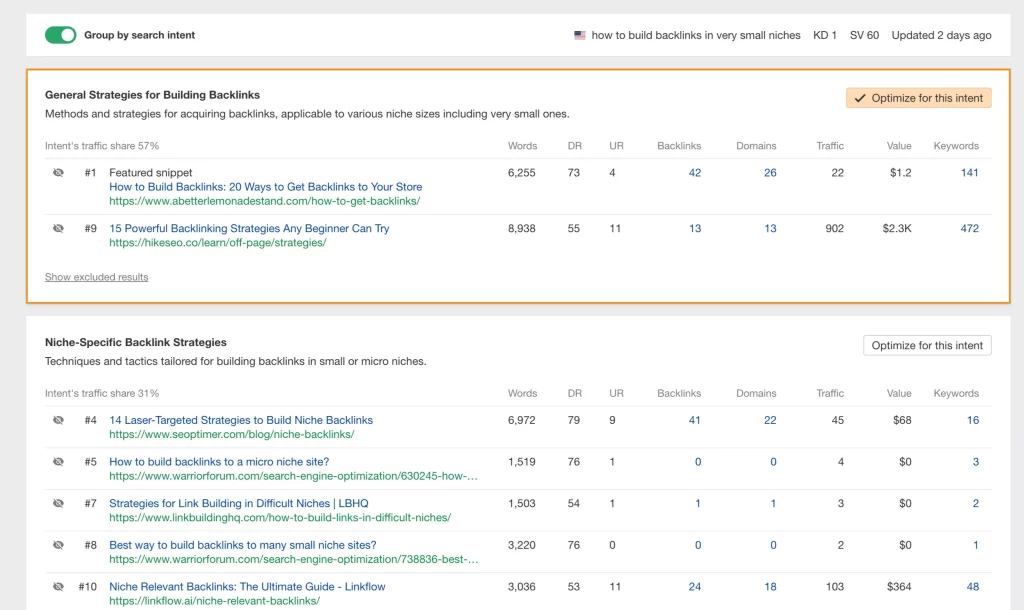
Of course, you won’t fully rely on these tools to make the content for you. As we know by now, adding the experience and experience (or the entire EEAT) elements to content creation makes it more user-engaged and more likely to climb Google’s SERPs for its respective keywords.
Use these tools just as a guide to support you with new ideas and differentiate your content so that it brings new information to the knowledge base and helps increase user engagement.
6. Monitor New Links to Competitors
Reverse engineering other sites’ links helps generate new link types that can only exist within your small niche.
For instance, one dominating unique link type in the wedding space is links from pages of wedding vendors, including florists and videographers. Given their local relevance, links from these types of pages give higher link equity than any other link type.
If you’re in this niche, you can expand your link prospects by doing Google searches for wedding vendors in your city to find a few more resource pages and directories where your florist or videographer (or your local business) could be included.
Scaling Your Efforts in Small Niches
While link building for small niches may present more challenges than having a big website that can reach multiple audiences, those few tips mentioned earlier could help you create a sustainable and impactful link building campaign.
By being more creative, persistent, and precise, you can expand your link opportunities and form genuine connections with partners and publishers within your industry.
SEO for the Google Maps Pack: Rank Better Locally
The Google Maps Pack occupies prime real estate on search results pages. It gets more clicks than your site will receive from ranking top spots for local organic search listings, making it an imperative area of local search optimization that marketers must take advantage of.
Even if you rank #1 for organic search listings, it’s still an excellent addition to your arsenal to dominate Google Maps Pack.
I’ve used it to rank one of my local businesses—a coffee shop in Bulacan and our franchise in Taguig—and have been driving nearby customers, making it one of the important channels to drive more physical visits to our stores.
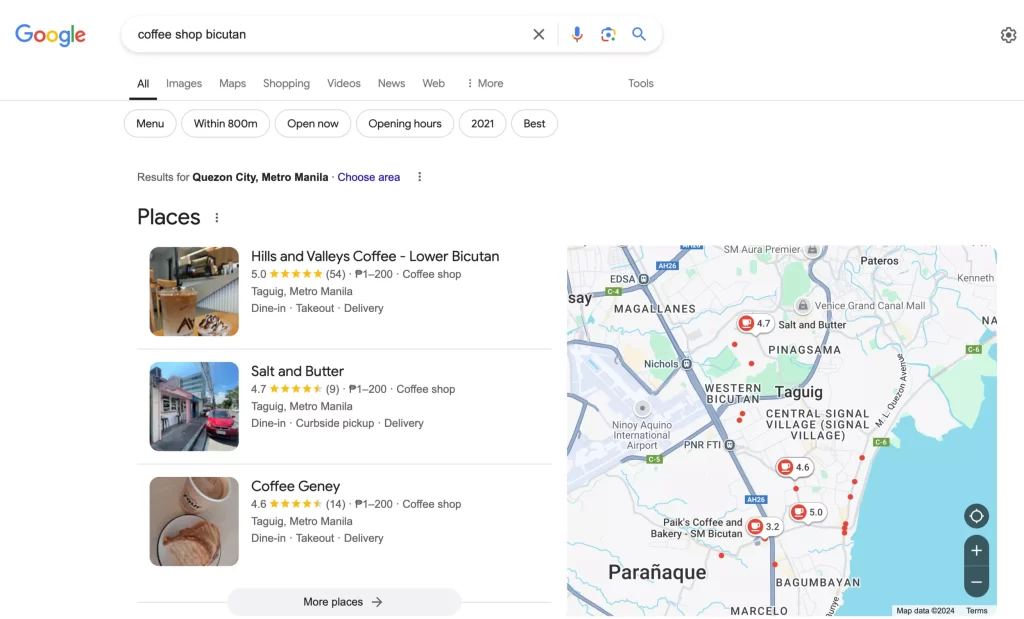
Here are some tips for leveraging SEO for the Google Maps Pack.
1. Claim Your Google Business Profile (GBP)
If your brand is famous in the industry and many customers visit your location, you may have a Google Business Profile visible on a search. You just need to claim it as its rightful owner.
Otherwise, if the store hasn’t opened yet, like in our case, weeks before our store opening, we already created our Google Business Profile for our upcoming branch.
Simply go to the Google Business Profile and follow the verification process. They usually will send you a code by mail or phone. Once verified, you can edit your Google Business Profile and optimize it for local searches.
Once you have claimed your Google Business Profile, fill out all the necessary details, including your Business Name, Address, and Phone Number. Spend as much time as necessary adding other important details in every information field.
The goal here is to provide as much context about your business as possible for Google to recognize it and to provide business information for your potential visitors.
2. Ask for Customer Reviews
Getting legitimate customer reviews helps Google recognize the authenticity of your brand and gives potential customers a glimpse of your business’s customer experience.
Whether the reviews are positive or negative, what matters most are actual reviews from your customers.
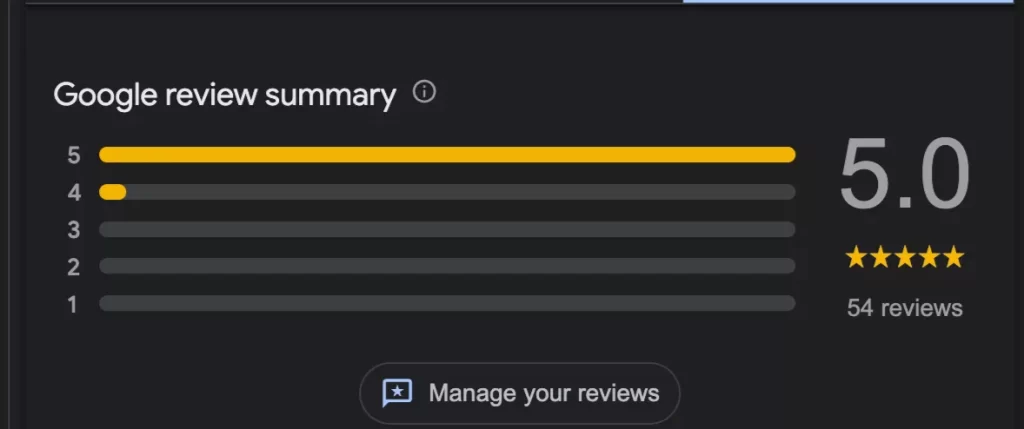
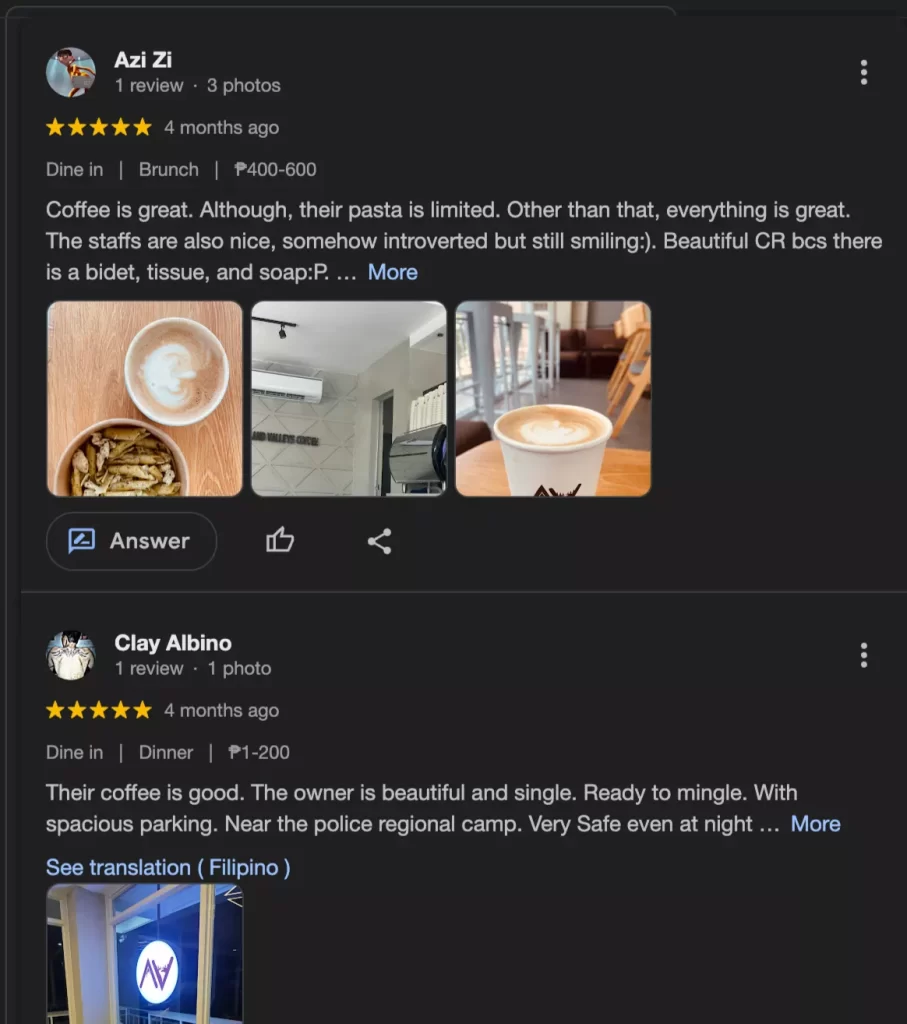
Here’s how to encourage customers to review your GBP:
Politely ask customers for reviews after a sale or service. Train your front liners (customer service or sales team) to request a GBP review from every satisfied customer. It doesn’t hurt to ask.
Send follow-up emails or texts with a direct link to your GBP review page. This could be through Viber or any other digital channel.
Another effective way to get reviews is incentivizing customers to review your product or service. For instance, during my honeymoon with my wife, we had a relaxing spa in Bangkok, Thailand. After the spa service, we were asked to scan a QR code, incentivizing us for the review - getting 50% off for the next visit.
You can also apply the same strategy to acquire new reviews for your GBP. Display signs in your physical location, encouraging people to give feedback.
Pro Tip: Respond to every review, whether positive or negative. This shows engagement and increases trust signals with future customers, showing you value every customer experience.
3. Choose the Primary Category That Aligns With What Customers Search
Google allows you to select a primary category and up to 9 secondary categories. Choosing the right primary category will enable you to appear first on Google Map Packs for specific search queries.
For instance, if you own a Bakery, choose “Bakery” over “Restaurant.” Match your primary category to your business’s core offerings.
Next, the second categories allow you to target additional search queries. For example, in the given bakery example, you could add “Catering” or “Dessert shop” as secondary categories to broaden your reach, enabling you to dominate Google Map Packs for any of those search queries.
4. Achieve NAP Consistency
NAP consistency refers to having the same Name, Address, and Phone Number across all online platforms and websites. Getting this right helps build your business's legitimacy in the eyes of Google.
By using tools like BrightLocal, you can automate monitoring of NAP across local citations and directories, helping you edit those profiles to match your business's exact NAP.
5. Get Local Citations
Part of doing link building for local sites is getting as many local citations as possible for your website. Create business profiles on Yellow Pages, LinkedIn, Yelp, and local business directories, as well as social media profiles such as Meta Page and LinkedIn Page.
Make sure NAP is also consistent across these local profiles.
You can use Whitespark to find more citation opportunities and manage the consistency of NAP details across these platforms.
6. Publish Localized Content
Increase the frequency and quality of localized content you publish on your site. Targeting localized keywords (e.g., "coffee shop in Bulacan") can help you dominate in more localized rankings.
Part of localized publishing is the ability to use local language and references that resonate well with your audience. So, for instance, if you want to write an article about “Top Coffee Shops in Manila,” you must include the specific places and addresses of these coffee stores while giving people exact directions.
If you ever visit the place, you may also recommend your favorite beverages. Adding personal insights and experiences could increase user engagement and enhance the helpfulness of your content.
7. Set Driving Locations to Your Business Address
Set driving directions to your business on Google Maps to make it easy for customers to find you. This is an underrated technique for climbing rankings on Google Map Packs.
As your potential customers use the directions on Google Maps, it generates positive signals for your GBP listing and improves more of its visibility.
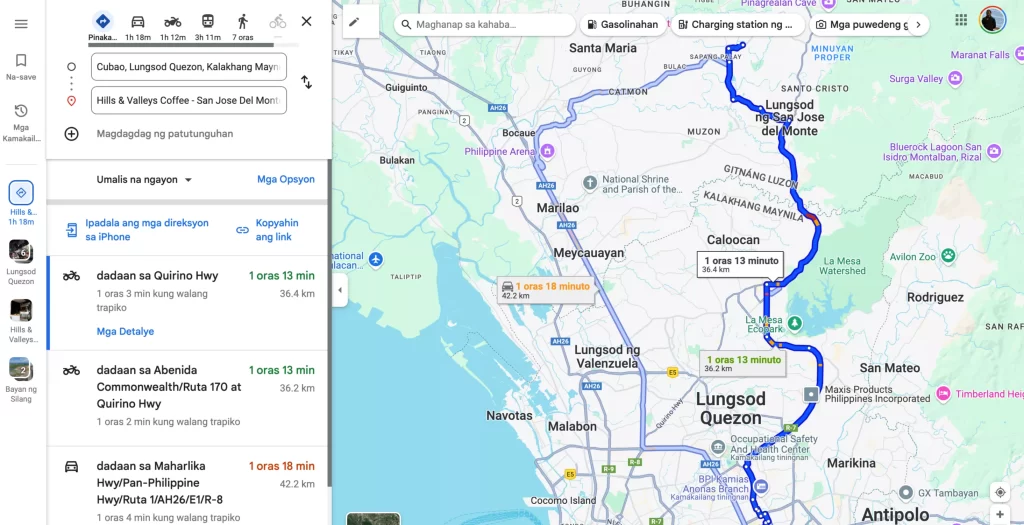
How to promote driving directions:
- Share your location links on social media. Include it when you’re writing captions to entice your followers to use Google Maps when finding directions to your store.
- Include your Google Maps and Waze links in email campaigns.
- Add “Find Us on Google Maps” to your website. Make it visible on the homepage, footer, or header.
8. Get More Engagements With Photos
Legitimate businesses have actual photos of their physical store, of their customers, and of their customer experience.
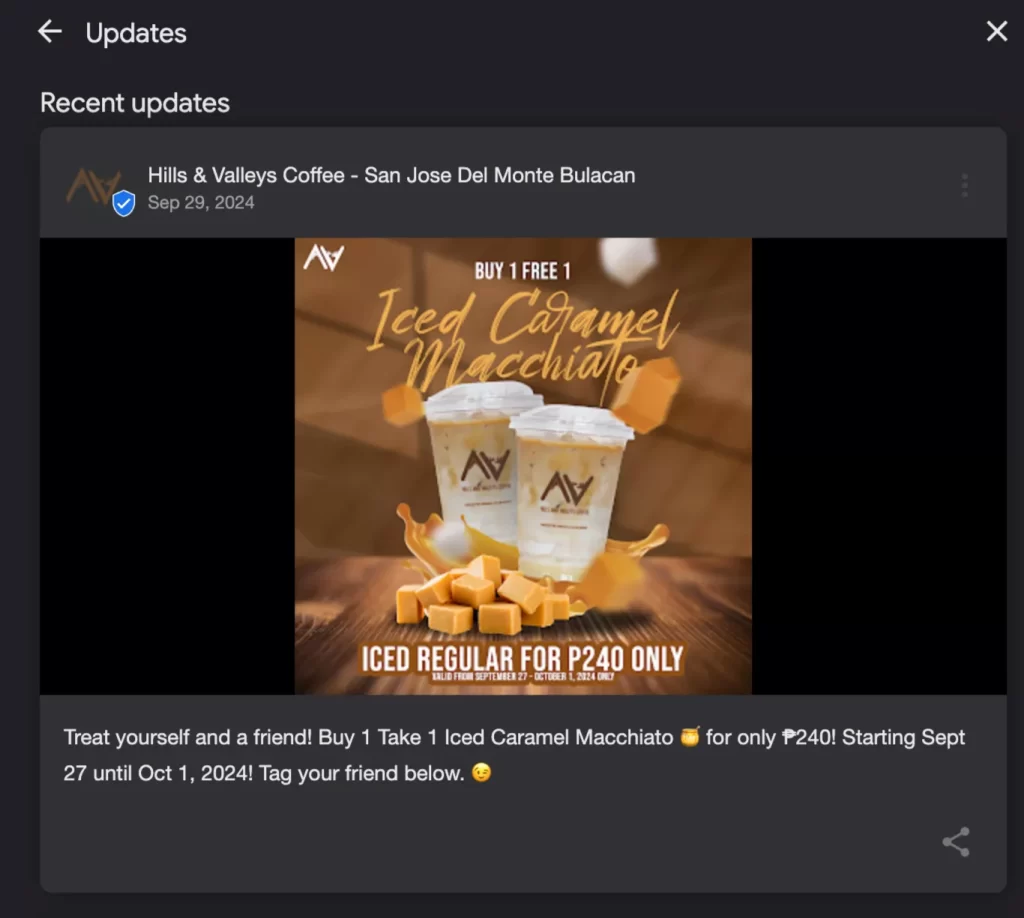
Upload images of your store, products, and team regularly to your Google Business Profile. You can also use geotagged photos to improve location relevance.
Tip: Ask your front-line staff to encourage customers to upload photos and reviews to your profile after visiting your business.
9. Infuse Attributes: Highlight Your Business’s Key Details
Attributes include features like wheelchair accessibility, vegetarian options, kid-friendly environments, and outdoor seating. These help your customers make the purchase decision, as they have nuances and preferences before visiting a store. For example, some customers would want to know if they can bring their pets to the store (so keyphrases like “pet friendly coffee shop” would be more likely their search keywords).
Navigate to the “Info” section in your GBP and select applicable attributes. Highlighting attributes not only improves your profile’s completeness but also appeals to niche audiences with a variety of preferences.
10. Upload New Offers to Your GBP
Regularly updating your Google Business Profile with offers and promotions keeps it dynamic and engaging.
For instance, we upload limited-time discounts, seasonal sales, and new product launches to our Google Business Profile at Hills & Valleys Cafe.
It is suitable for local rankings and keeps our existing customers updated with our latest store campaigns, which would keep them visiting more often.
Be Intentional in Ranking Your Google Maps Pack
Maintaining a Google Business Profile may be an underrated strategy for some, but if taken seriously, it could drive more search visibility and foot traffic to your stores.
As more people use Google to search for nearby stores for their daily needs, you’ll likely attract new customers organically if you rank for Google Maps Pack, without spending a single dime on advertising.
6 Low-Hanging Fruit SEO Tactics: A Practical Guide to Quick Wins
SEO is a dog-eat-dog mentality, where one competitor can smash rankings in Google’s SERPs within weeks of implementation.
Building momentum requires seeing quick wins from investing your resources into the right opportunities. It builds your SEO confidence and gets more acceptance from stakeholders.
That’s where low hanging fruit SEO comes in.
Low-hanging fruits in SEO represent opportunities that require minimal effort but deliver significant impact.
Getting quick wins for your client's SEO is a major part of the strategy to get more buy-in for your client’s SEO investment and sustainably deliver results by managing expectations early on.
You can improve search rankings, traffic, and overall website performance by identifying and acting on these low-hanging fruit SEO opportunities.
In this guide, I’ll give 6 actionable low-hanging SEO fruits to solidify your first quick wins.
1. Optimize for Low-Hanging Keywords
You can significantly impact search traffic by moving a page ranking in position 6 to the top 3 spots. Instead of waiting for a new page to be visible on search, it’s always easier to move a page that’s been winning already.
Use tools like Ahrefs or SEMRush to find keywords where your pages rank below 5th position - position 6 to 20. By moving these pages to climb their SERP rankings, you’ll expect to see an increase in search traffic.
For instance, if your collection page ranks in position 15 for "violin for beginners”, optimizing it with richer content and better on-page SEO can push it to the top 3.
2. Update Existing Content to Ensure Relevance
Refreshing outdated content is another low-hanging fruit tactic with high returns.
We experience SERP volatility more today than in previous years, with new SERP features being added to the mix and rankings pages shuffled to match user intent—so it’s a must to keep existing content updated to meet users’ needs.
Go through each existing piece of content. Prioritize the ones that are performing but have had declining traffic in the past six months.
When updating each piece of content, ask, "Is the information on this page still aligned with my target readers' current interests, challenges, and needs, and does it offer fresh, actionable insights to keep them engaged?"
Content updates require the author's expertise to see clearly which sections of the page need a revamp and what particular sections or new sets of questions to answer to add new information to the industry's body of knowledge.
For instance, we published “how to start a coffee shop in the Philippines” a year ago, and I was looking for new sections to add or revise based on my observations in the industry. These are samples of our new draft sections:
- How to hire and train baristas—with sections to localize job applications and interviews to hire staff who live near the stores (an advantage point given the state of traffic in the Philippines).
- How to generate new ideas for menu selections and beverages—To keep up with consumers' changing demands and tastes, a new coffee shop owner must know how to offer a new product selection that best correlates to the current taste of their target customers.
- How to destress and prevent burnout for cafe owners—Cafe owners are concerned about getting burned out as they run their day-to-day operations. So, it’s important to add this section to help them maintain their mental health and sustainably operate their business.
These new sections didn’t come from ChatGPT answers or regurgitated content from other coffee blogs. They are entirely based on my experience as a cafe business owner.
When updating content assets, you can interview experts and industry thought leaders for new strategies, insights, and research data to solidify the quality and ensure the relevance of your content piece (e.g. see what Ahrefs did with their list of link building strategies - they get fresh insights from well-known SEO practitioners).
3. Turn Unlinked Mentions into Links
Unlinked brand mentions are mentions of your business or products on external sites that don’t link to your site. The bigger the site and the more products and content it churns out, the more unlinked brand mentions you can find.
We’ve been using BrandMentions and Ahrefs’ Alerts to find branded mentions and get monthly alerts quickly. While, of course, there are other tools for this functionality, the best thing about these two tools is that they have a wider search database you can trust for more branded mentions.
A couple of branded mentions you should convert into links:
- Editorial content that mentions your brand, product, or content
- Press page and coverage of your expertise and thought leadership - mentioning names of authors, leaders, and personalities in your organization (best if you can publish author pages before you send emails so publishers can simply link to the author page).
- Mention on links/resource pages or “where to buy pages” with no embedded links.
Do link outreach to site owners or publishers of pages that mention your site and ask them for backlinks. This link building strategy has a higher conversion rate than cold link request outreach campaigns.
4. Don’t Neglect Long Tail Keywords
The advice to go after high-volume, commercial keywords requires an understanding of the current context of the SEO campaign.
If you have a site with significantly higher domain authority, you can publish new relevant content and expect it to appear on Google’s SERPs quickly.
However, you can’t expect a relatively new site to dominate head terms very early on with no existing rankings from its other pages.
To get early quick wins, target long tail keywords (keywords with four or more words) that have longer search strings than head terms but are easier to rank with content optimized with on-page SEO fundamentals.
I find two ways helpful in looking for long-tail keywords that are easier to rank, assuming you’ve got content that satisfies user needs.
1. Use Ahrefs to find long tail keywords from a head term or topic you’re eyeing to rank for with your website.
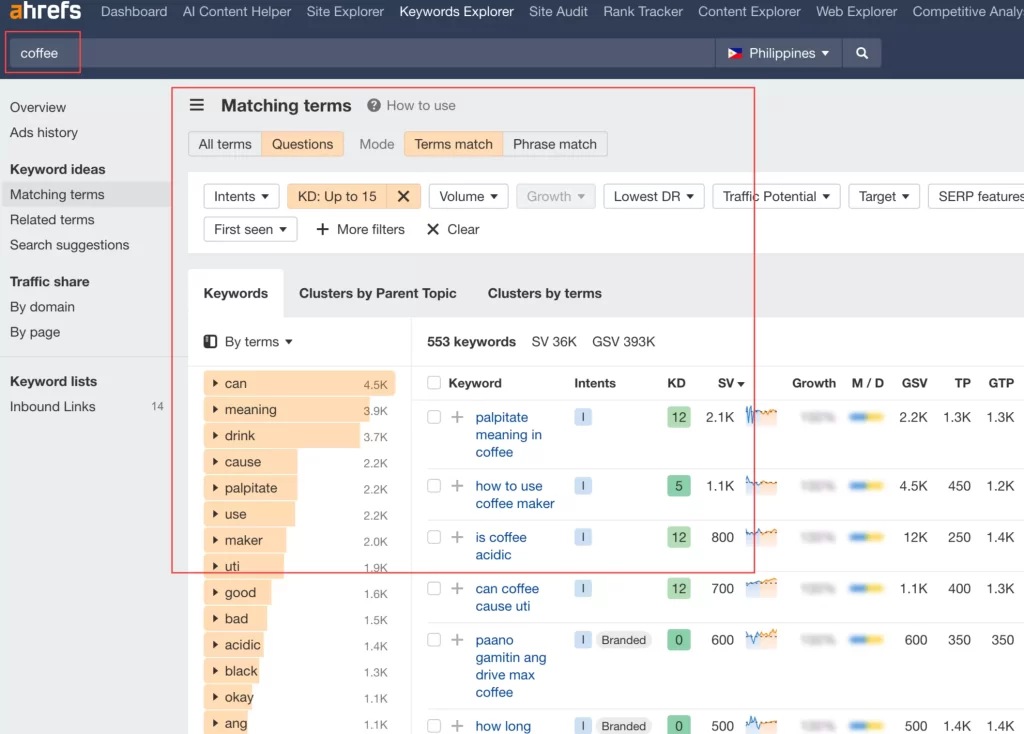
2. Find new long-tail keywords your pages can rank for.
Go to your top pages and see which content captures rankings for long-tail keywords sitting below page 1.
With a few optimizations, such as adding new sections to rank for these long-tail keywords, your content would likely increase its search traffic.
5. Publish More MOFU and TOFU Content
You don’t get sustainable rankings by expecting all product pages to rank for their commercial keywords.
One holistic content strategy is to publish informational content for keywords that lead people to their purchasing decisions.
With 15% of total searchers being new, content publishing offers an ocean of opportunities.
Start creating content to tackle comparative keywords such as “vs” or “best” phrases, which often have low competition but high traffic opportunities.
For instance, creating a blog post titled "Best Winter Jackets vs. Coats: What’s Right for You?" targets users seeking guidance while naturally incorporating relevant keywords.
Build content that answers common user questions, showcases expertise, and drives product or service page traffic. Linking these posts to collection and product pages strengthens the structure of your website and distributes link equity across pages.
Whenever you publish new content, ensure it links to related existing pages. This helps users navigate your site and signals search engines about the relationships between pages.
6. Collaborate with Active Authors
One overlooked strategy in content publishing and link building is expert collaboration.
Creating helpful content that satisfies users with new information takes a lot of work on the back end (research) and front-end publishing (editing). By getting new insights from other authors who are also practitioners in their industries, you solidify the credibility of your content piece, which increases its acceptance by your target readers.
If you don’t have any authors in mind, start reaching out to them by first populating a list of active authors in your space. You can use Ahrefs to find these active authors.
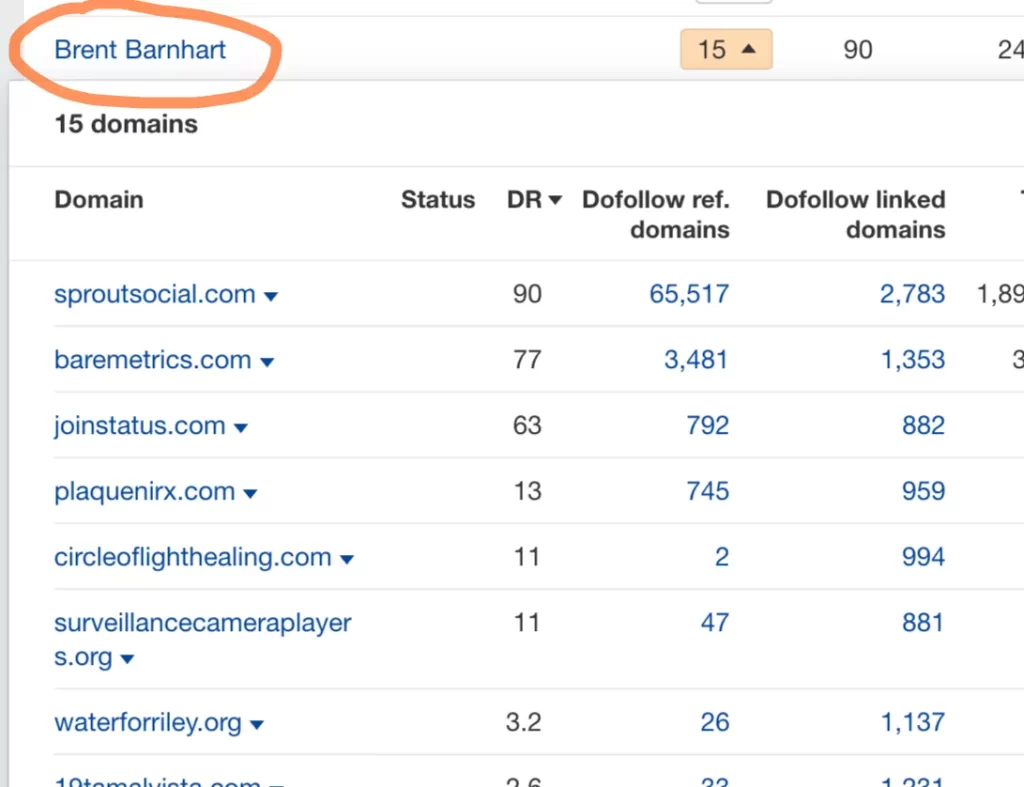
Another way is to publish “accepting guest post” or “become a contributor” pages to attract publishers to contact you for collaboration.
Obviously, not everyone is a good candidate, but getting one or two who surely know what they’re talking about is worthwhile for a content collaboration.
Fire Bullets, Then Cannonballs
SEO, in offense, must be a combination of firing bullets and cannonballs. While aiming for greater impact with high-intensive efforts, you are shooting for results with bullets—low-hanging fruits SEO. This enables you to build a solid momentum of an SEO campaign.
While everyone waits for significant results from their high-intensity work, you get consistent, quick wins with your bullets. There are small things that you can add to your SEO arsenal, giving you a head-start advantage in your competition.
Content Strategy and Link Building for Google AI Overviews
As search evolves, the rise of AI overviews in Google results brings fresh opportunities for visibility, but the fundamentals remain the same. While it’s not about optimizing content solely for AI, a strong SEO foundation enhances your brand’s presence across all search experiences, including AI-driven results.
The essentials of SEO—well-structured, unique, and genuinely helpful content—continue to be the bedrock of visibility. However, as digital marketers aiming to build authority and relevance, we can consider AI Overviews as an additional layer that increases brand exposure.
AI overviews offer the chance for brands to surface in a different light, adding an opportunity for expanded visibility in high-quality content spaces.
Content Strategy and Link Building for Google AI Overviews
Developing a solid link building and content strategy is pivotal to achieving the right positioning in AI overviews. The key to success is consistently updating content to match user intent, answering complex queries, and designing content that fulfills user needs.
1. Monitor SERP Features for Target Keywords
Monitoring SERP features helps you stay competitive. Some queries now feature AI-generated summaries, videos, images, and other multimedia elements. For example, Google may display a “People Also Ask” section, AI-generated overviews, and even knowledge panels for specific keywords.
Tools like Ahrefs, and SEMRush can identify which keywords yield SERP features, like AI overviews, that may benefit from multimedia content additions. This data enables you to adjust your content by incorporating structured data, images, or videos.
2. Creating High-Quality, User-Focused Content with EEAT
High-quality content, especially when structured for user engagement, enhances your visibility potential across search types. Google’s EEAT (Expertise, Experience, Authoritativeness, and Trustworthiness) are critical for ranking in AI-driven search.
Focus on creating original perspectives that add value (information gain), grounded in genuine expertise and real-life experience. Google’s AI algorithms identify rehashed content and can now better recognize authentic, informative resources.
Showcase your expertise by weaving in firsthand examples, studies, and insights that differentiate your content from competitors. Content that draws from expertise is more likely to rank and appear in AI-driven summaries.
3. Deep Dive into Audience Research and Core Topics
In-depth audience research is non-negotiable in aligning content with user intent and needs. Google’s ranking systems now prioritize content relevant to a website’s primary purpose. Publishing content that strays from core topics risks diminishing your authority in Google’s view.
Create audience personas to understand what your audience values. Develop content around these insights to ensure they resonate and fulfill their needs.
Ensure each piece of content addresses your audience’s pain points and challenges. If your site focuses on digital marketing, avoid publishing unrelated topics, as Google now distinguishes unrelated content sections within a site.
Google recently noted a shift in visibility for sections of sites like “Fortune Recommends” and “Forbes Advisor” due to disjointed content that wasn’t fully aligned with each site’s primary theme.
4. Link Building That Complements Core SEO
Backlinks remain crucial for reinforcing authority, yet placement has become more strategic in AI. Here’s how to build links that serve both organic search and AI-driven summaries:
- Be strategic in placing links on entities and sites you want to be topically associated with your brand.
- Consider sentiments in the context of the page's/content's overall message. Ensure they promote a more positive perception of your product/service and do not work against your offerings.
- Be on the lookout for links/resources/where-to-buy pages that can demonstrate your products' POV as they get included in the lists pages.
- Make quality control part of your process when checking the entire context of the page/content from which you aim to get links. Not only is it relevant to your site, but it must also help improve the association toward solving problems your prospective customers are experiencing.
5. Optimize Content for Complex Queries
With generative AI allowing users to ask intricate questions in one search, optimizing for query chains—consecutive follow-up questions—is more effective than targeting isolated keywords. By addressing connected topics, your content appears more thorough and relevant.
Write comprehensive guides that anticipate follow-up questions. For instance, if you write about “digital communication skills for HR,” also consider covering “how digital skills benefit talent development” or “common challenges HR faces in digital communication.”
By structuring content with linked topics, you increase the chances of AI identifying it as useful for multi-layered searches.
6. Publish Short-Form Videos Directly on Your Site with Structured Data
While platforms like TikTok, Instagram, and YouTube are popular for short-form video content, don’t overlook the value of hosting these videos on your website. Tools like Wistia can enhance video quality and user experience on your site.
By embedding videos directly, you keep traffic on your domain and have better control over the content’s SEO impact. Additionally, mark up your videos with structured data to make them more discoverable in Google Search and eligible for inclusion in AI overviews.
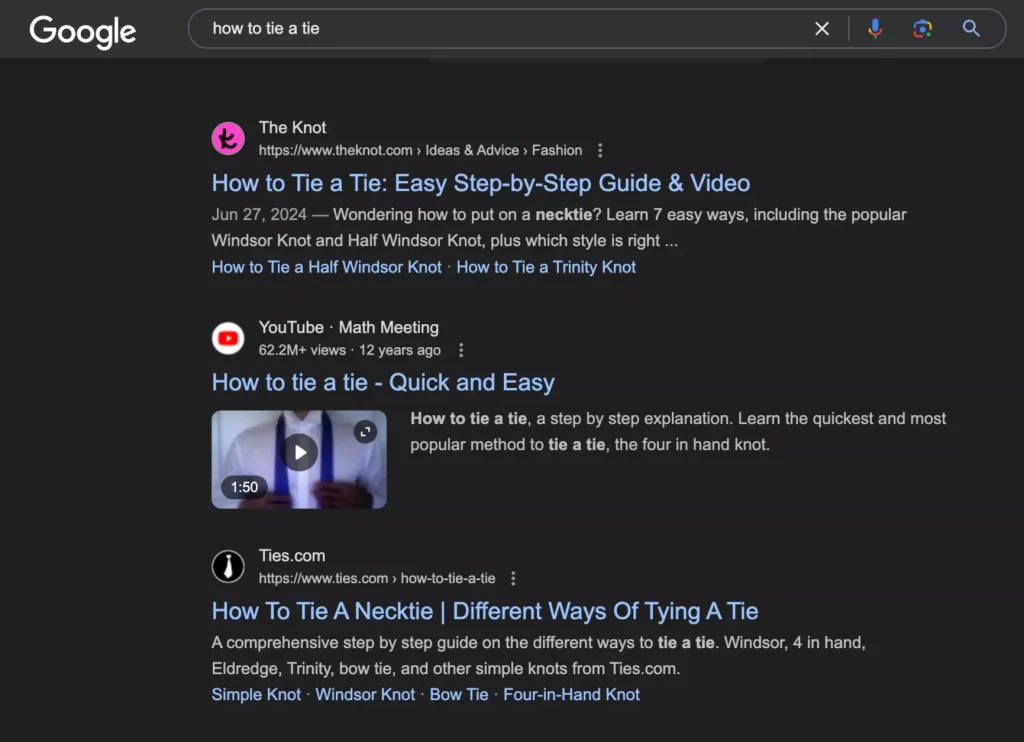
Embed product demos, explainer videos, or testimonials directly on relevant landing pages and use structured data to signal their relevance to Google. This can improve visibility in both standard search results and AI-driven summaries.
7. Enhance Sales Pages with FAQs and FUQs (Frequently Unanswered Questions)
Adding FAQs to your sales pages immediately answers common customer questions, enhancing user experience and optimizing for AI overviews. FUQs, or frequently unanswered questions, address nuanced or lesser-known queries, showcasing your in-depth expertise and understanding of the customer journey.
Identify customer pain points and unique questions that arise during the sales process. Incorporate FAQs and FUQs into your content strategy to address these needs proactively. This thoughtful design positions your content as a comprehensive, reliable source in current search results and evolving AI landscapes.
Positioning Content for Future Search Landscapes
Incorporating these practices prepares your content for success in an evolving SEO landscape, where AI-driven summaries may soon become more prominent. By blending traditional SEO with AI-conscious content practices, you build an adaptable content strategy that remains resilient in a changing environment.
The essentials—quality content, strategic link building, and user-focused design—create a content approach that thrives in AI and traditional search results, establishing your brand as a trusted source.
Types of Backlinks That Impact Your SEO (and How to Get Them)
Link building has always been one of the most challenging areas of SEO.
It will get more difficult these days, especially in highly competitive spaces, as most Google core updates and HCU updates strongly favor brands (sites with stronger link profiles, brand searches, and mentions from reputable sites), emphasizing the need for better types of backlinks.
The notion of getting only quality links doesn’t apply in ranking sites today. Link building should be about getting more quantity of the quality links that count.
Google’s algorithms are smart enough to distinguish between a high-quality editorial mention and a spammy, low-value link. Focusing on quality links alone won’t make it. You have to acquire more to maintain rankings and strengthen brand positions.
The links you aim to build should meet at least these two primary criteria:
- High-quality: Links from authoritative, relevant sites within your industry.
- Hard-to-replicate: Links that your competitors cannot easily reproduce, giving you a competitive advantage.
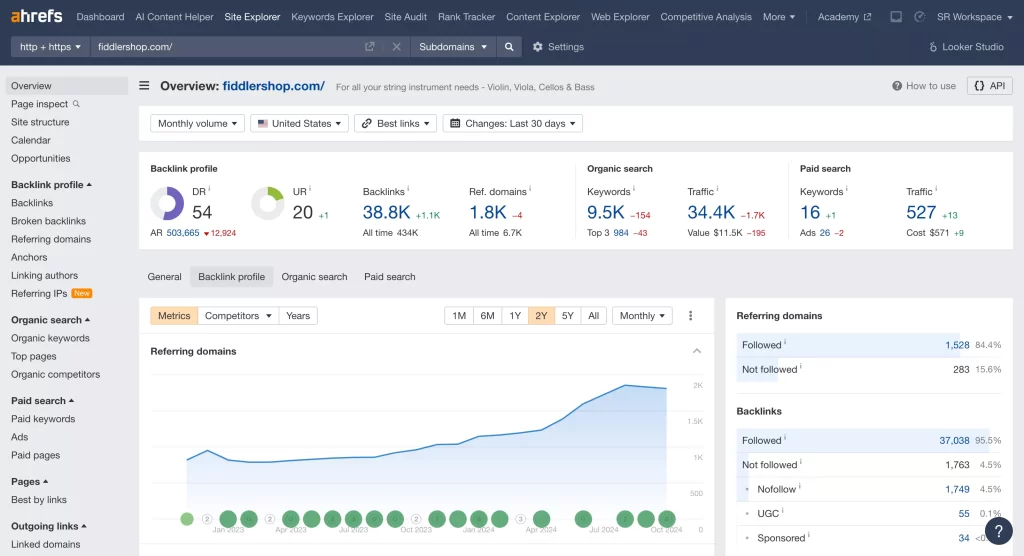
So, what are the types of backlinks that matter today?
1. Editorial Links
Editorial links are highly coveted because they signal authority and trust. These links come from natural mentions in articles, blogs, and other media without a direct request from you. Earned links through strong content, positive press coverage, or expert quotes are strong indicators that people trust your site, which helps your pages climb higher in Google’s SERPs.
Why They Matter:
- They are seen as the most organic form of a backlink, showing that other authoritative sources value your content. These links are referential in nature and could only be acquired if you have great content published on your site or if you have a link-worthy product.
- They help position your brand as a leader in your industry. Editorial links from reputable sites can serve as social proof and enhance your thought leadership.
- Drive referral traffic from reputable sources, increasing the likelihood of converting visitors into leads or customers. When other publishers recommend your product/service through links, it’ll help assist conversions.
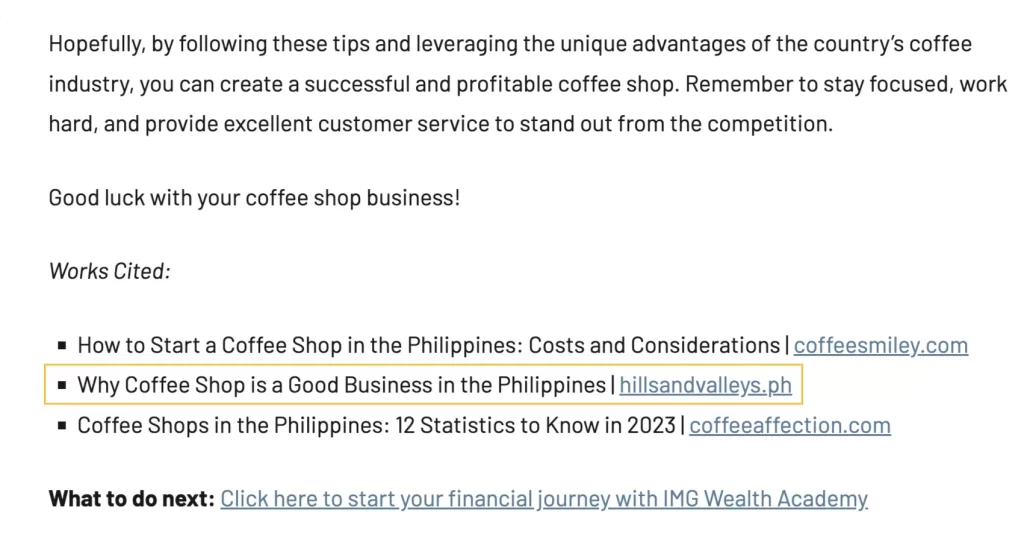
How to Get This Type of Link?
- Publish High-Utility Content Assets: Create content that fills a knowledge gap in your industry, such as in-depth guides, unique case studies, or proprietary research. Content that educates or provides a solution naturally attracts editorial links. In today’s age, providing new information (“information gain”) is critical as it attracts established authors who are looking for new bread of industry information for their audience.
- Leverage PR: Use media outreach to promote new products, reports, or expert opinions that could be picked up by publications or influencers in your field. Subscribe to Mark Rofe here, as he shares actionable regular tips on how to utilize digital PR to its fullest.
2. Links That Drive Second-Hand Traffic
These backlinks come from niche forums, community discussions, or recommendation pages, and while they may not carry the same SEO weight as editorial links, they’re highly valuable for driving targeted, second-hand traffic.
It is usually known as second-hand traffic, but it doesn’t diminish its value. The traffic that comes from recommendation and community sites is as powerful as editorial links.
Why They Matter:
- Links from community-driven sites (such as niche forums or “how-to” pages) often bring users who are further along in their decision-making process. These visitors are more likely to convert as they arrive at your site already looking for solutions or recommendations.
- They create diversified traffic streams, making your site less reliant on organic search traffic.
How to Get This Type of Link?
- Engage in Niche Communities: Participate in niche forums or communities where your target audience hangs out. Contribute genuinely by sharing insights and solutions, which can lead people to link to your site as a resource. Pro Tip: Don’t try to push hard on your product recommendations if they are not relevant. It would otherwise backfire on your brand if you do so.
- Provide Solutions on Q&A Sites: Sites like Quora or Reddit can be goldmines for getting these types of links. You can gain backlinks and traffic from these platforms by answering questions and providing value.
- Invest as much time to see opportunities further. When there are opportunities to add value with your product recommendations (as authentic and as useful as they can be), don’t hesitate to answer in the discussions.
3. Links From Ranking Pages
Links from pages that already rank well in search results carry a unique value. These pages receive a constant flow of organic traffic via rankings, and the authority from their position in the rankings can pass on to your site.
I see it as banking on other pages’ authority, as these pages may be seen as relevant to certain queries I may have wanted to rank for either informational or commercial keywords.
Why They Matter:
- Ranking pages are highly authoritative in the eyes of search engines, so a backlink from them holds more weight.
- They ensure a steady flow of referral traffic, as users continually find these pages through search.
- These links often come from content that is highly topical relevant to your site, further boosting your rankings in specific keyword niches.
How to Get This Type of Link?
- Outreach to Ranking Sites: Identify sites that rank well for your target keywords, and offer value through guest posts or content collaborations through SEO outreach. Focus on content that enhances their ranking pages, like providing an expert opinion or data that complements their existing material. Make sure you’re adding unique information that isn’t yet found on the page to increase the likelihood of getting your pitch noticed (and hopefully acquiring the link from the page).
- Get Included in Listicles: Reach out to sites that create “best of” or “top X” lists related to your niche. Offering a compelling reason why your product or service should be included can earn you a spot on these high-traffic pages. See which angles or unique POV your products or services could offer that would be irresistible to add to the page.
4. Contextual Links from Distributed Content
Contextual links embedded within relevant content (such as guest posts, listicles, or interviews) are highly valuable because they integrate naturally into the flow of information and provide search engines with strong context about your site’s relevance.
Compared to reaching out to get added, you need a compelling reason—a content piece that adds new information to the industry’s knowledge base—to have a chance for link placements.
Why They Matter:
- Contextual links within content carry more SEO weight than sidebar or footer links because they are part of the main content, signaling to search engines that they are directly relevant to the topic.
- These links also tend to drive better referral traffic since they appear organically as part of an informative resource.
How to Get This Type of Link?
- Guest Posting on Targeted Sites: Focus your guest blogging efforts on sites that serve your intended audience. Aim to provide content that adds value and is relevant to the readers of those sites. Pro Tip: we use Ahrefs’ Domain Rating (DR) and SEMRush Traffic to see if a potential publisher is worth contributing content to. Benchmark must be Ahrefs’ DR 25 and above, and with existing organic traffic of 1,000, and without history of traffic drop (or algorithmic penalties).
- Leverage Your Author Portfolio: If you’ve built a portfolio of high-quality content, use authorship as leverage to contribute to reputable sites with high Domain Ratings (DR). Match your contributions to your professional profile, which increases your chances of landing a contextual backlink on relevant sites. Pro Tip: If you’re working with SEO clients, you can use thought leaders or in-house experts in the company who want to build their personal brand. Collaborate with them by assisting them in doing the outreach yourself and letting their content be submitted with links to their personal site and your client’s site.
5. Thought Leadership Links
Thought leadership links come from opportunities such as public speaking, podcasts, and interviews. These links establish your authority in your niche and extend your digital footprint beyond written content.
Why They Matter:
- Links from organizations or events where you’ve presented establish you as a thought leader and build credibility not just with search engines but also with your audience. They also help your site optimize for large language models (LLMs) like ChatGPT, Perplexity, and AI Overviews, which rely on information from other publishers.
- They can diversify your backlink profile by incorporating non-traditional SEO sources, making it harder for competitors to replicate. This type of backlinks require depth of expertise and personal brand to garner a chance.
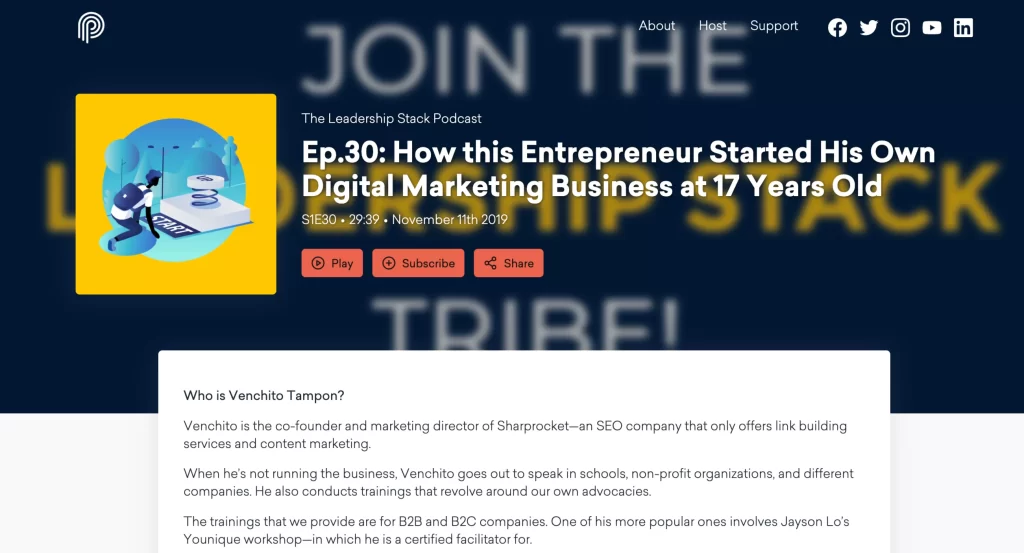
How to Get This Type of Link?
- Guest Speaking: Look for opportunities to speak on podcasts, at conferences, or in webinars. This builds your authority and earns you backlinks from the event or podcast host’s site.
- Leverage Personal Interests: If you have interests outside of your professional domain (e.g., personal development, productivity), use these as angles to land guest spots on podcasts or content collaborations outside your main niche. These can still drive relevant traffic to your site. For instance, I do corporate training on topics related to personal development, leadership, career, sales, and customer service. This allowed me to diversify my approach to guesting that other SEO and digital marketing speakers can’t easily access to unless they have similar personal interests.
6. Product-Led Links
Product-led links are earned by offering valuable tools, templates, or services that can be highly utilized by targeted audiences. They act like an extension of a first-touch experience, as they get to have immediate access to premium features your tools provide.
Why They Matter:
- Offering no-cost products like calculators, checklists, or apps can generate consistent backlinks because these resources are highly shareable. It also helps potential customers convert, as they get to experience first the value before making a purchasing decision.
- These backlinks are sustainable since they continue to attract new links as more users discover and share your product.
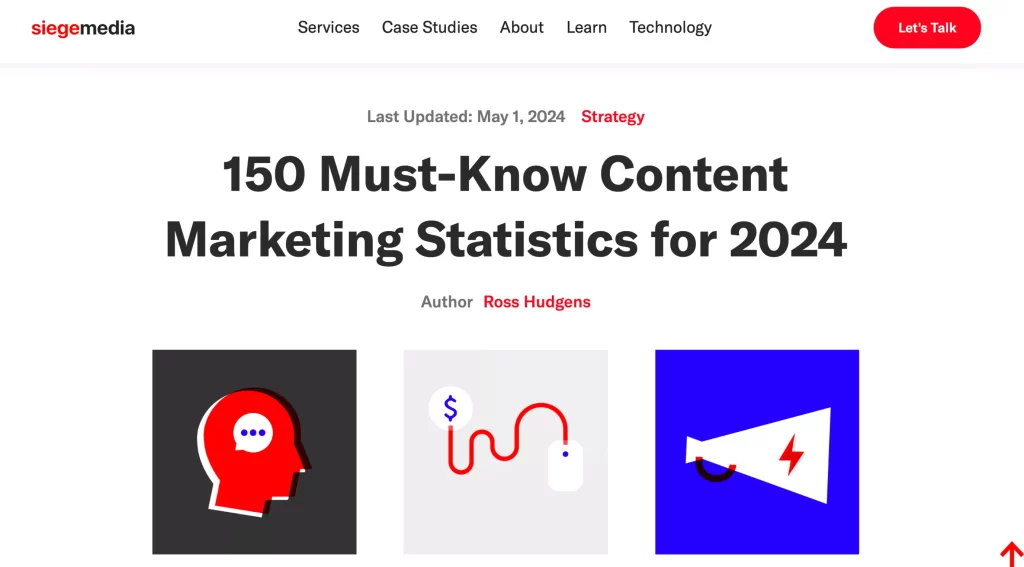
How to Get This Type of Link?
- Develop Free Tools or Resources: Create high-utility resources like free templates, checklists, or tools that your target audience finds useful. Distribute them through your site or platforms like Product Hunt to get the word out.
- Ask your networks in the industry to share your new tool or resource: Send emails to friends and networks in your space to gain early traction for your product-led content assets.
- Outreach to Resource Pages: Actively promote your tools or services to websites that curate lists of free tools. These pages often attract significant traffic and can generate long-term backlinks.
Get The Type of Backlinks That Count
Not all backlinks are equal in SEO value, and understanding which types of backlinks move the needle for your business is crucial.
Focus on building hard-to-replicate, high-quality links that enhance your authority, drive traffic, and generate leads.
Whether it’s through editorial mentions, contextual links, or product-led backlinks, prioritizing quality over quantity will lead to more sustainable SEO success.
SEO-Driven Content Marketing For Startups
Create content that ranks and converts.
SEO-driven content marketing aims to rank pages and engage users so that they will convert.
While most SEOs vouch for just rankings, I do believe that content marketing activities should impact the business goals and objectives ─ and any marketing activity, for that matter.
In this guide, we’ll explore tips on utilizing content marketing for startups to drive SEO impact to your website.
1. Turn Audience Research to Content Clusters
Start by understanding the needs, interests, and challenges. This can involve creating a buyer persona that speaks to the demographic and psychographics of your target audience. Getting fresh data from your management team can also help pinpoint who your customers really are.
Create your ICP (Ideal Customer Profile), which describes your business' ideal customer based on common attributes like demographics, behavior patterns, needs, and pain points.
Then, use tools like Sparktoro or Ahrefs to discover topics and questions your ideal customers might be searching for to find solutions.
When looking for topics, ensure you tap into each stage of the marketing funnel (Awareness, Interest, Desire, and Action), or in the digital marketing realm, we have BOFU (bottom of the funnel), MOFU (middle of the funnel), and TOFU (top of the funnel).
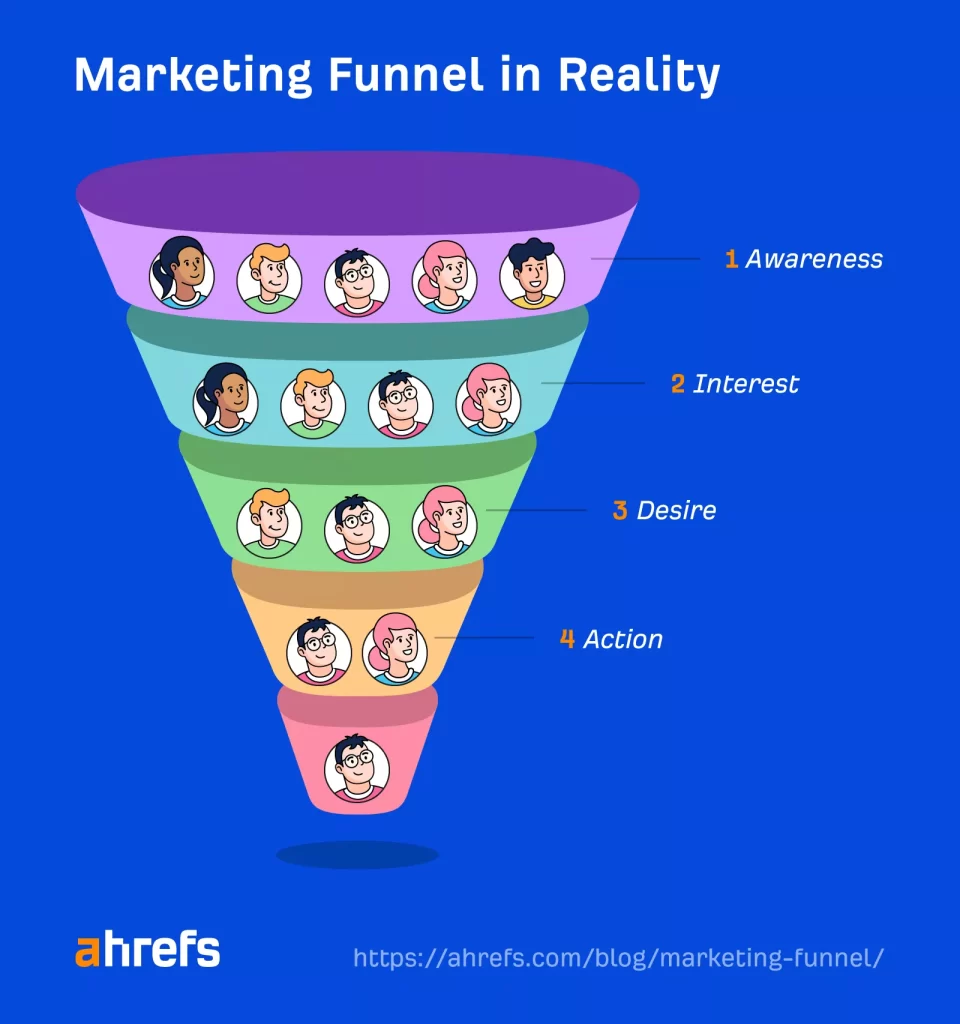
Even if it’s not a product/service page you’re publishing, you can still convert customers on your pages in the TOFU funnel (informational pages) as long as you deliver solutions to their needs and contextually place a solid call to action on your landing pages.
Here are a few steps to building effective topic clusters:
- Identify Core Topics: Identify 3-5 broad topics that align with your startup’s services, products, or expertise. These will become your pillar pages.
- Conduct Keyword Research: Use tools like Ahrefs, SEMrush, or Google’s Keyword Planner to find relevant keywords related to your core topics with significant search volume. Pro Tip: Do not skip zero-volume keywords that must be part of your content marketing base.
- Create Subtopics: Based on the keyword research, identify subtopics that address various facets of the core topic.
- Link Your Content: Interlink your pillar page with cluster pages. Internal linking helps search engines better understand your priority pages and improves the crawling and indexation of your new pages.
For instance, If your startup offers project management software, your pillar topic could be "Project Management Techniques". Cluster pages could cover subtopics like "Agile Methodology”, "Kanban vs. Scrum”, and "Project Management Tools for Startups”.
Publishing these product-led linkable assets can also lead to more link building opportunities while driving new users to your product or service.
2. Enlarge Your Publishing Base Through People-First Content
People-first content is about creating valuable, relevant, and high-utility content that meets the needs and expectations of your intended audience.
We’ll examine these four critical components of people-first content (Jason Acidre’s framework).
Needs Met
“Needs Met” is about how well your content matches the searcher’s intent and fulfills their expectations. Here’s how to ensure that your content meets this criterion:
- Intent Matching: Ensure your helpful content answers the exact queries your audience is searching for. Use tools like Search Console to identify common keywords and adjust your content to fulfill informational or commercial intent. Avoid misleading click-bait titles that don’t deliver on their promises.
- Target a Single Topic & Intent: Focus on a single topic, providing clear and concise answers without overwhelming the reader. Avoid burying essential information in long, multi-topic content. Consider using separate pages for subtopics with significant search volume.
- Direct Answers to Main Queries: Present direct answers prominently above the fold using formats like Quick Answer Boxes, Key Takeaways, or Summaries. This approach caters to users seeking quick information, especially on mobile devices.
- Remove Fluff Content: Keep your writing concise and relevant, eliminating off-topic, redundant, or overly wordy sections to maintain clarity and improve user experience.
For instance, in every blog post I write for our corporate training blog at Rainmakers, I determine the user intent of each search query. Asking the question, “What do they want to know first?” helped me prioritize points (and put them above the fold) so it would immediately satisfy the user's needs.
Here’s a recent post on “What is leadership to you?” The searchers would likely be students and learning and development practitioners who are looking for different schools of thought on the subject.
I delivered what they needed, based on my expertise on the subject:
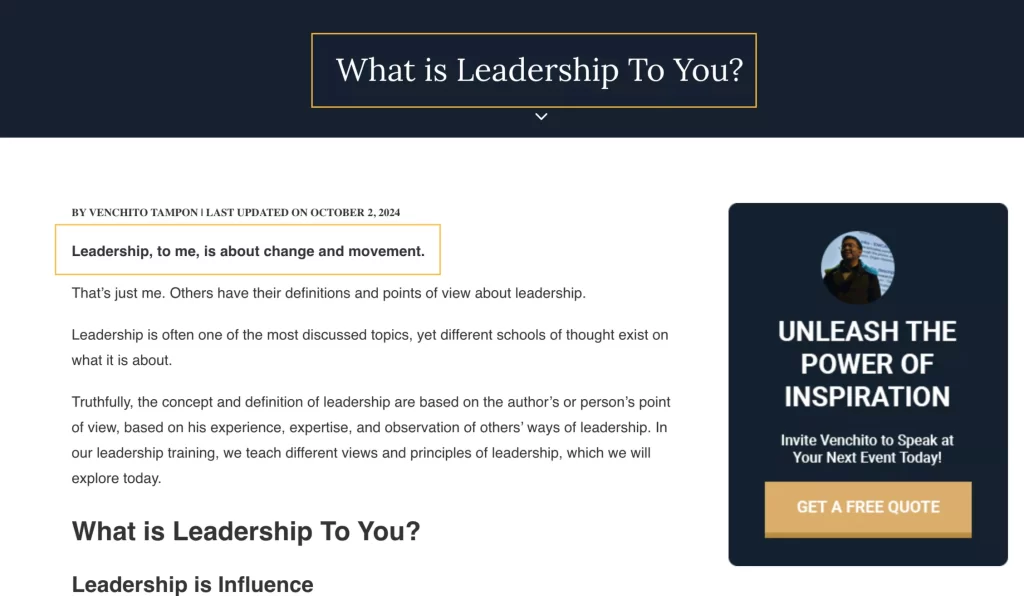
Another example is my coffee shop blog. We meet users’ needs by providing direct answers to certain questions (e.g., how much does it cost to start a coffee shop?).
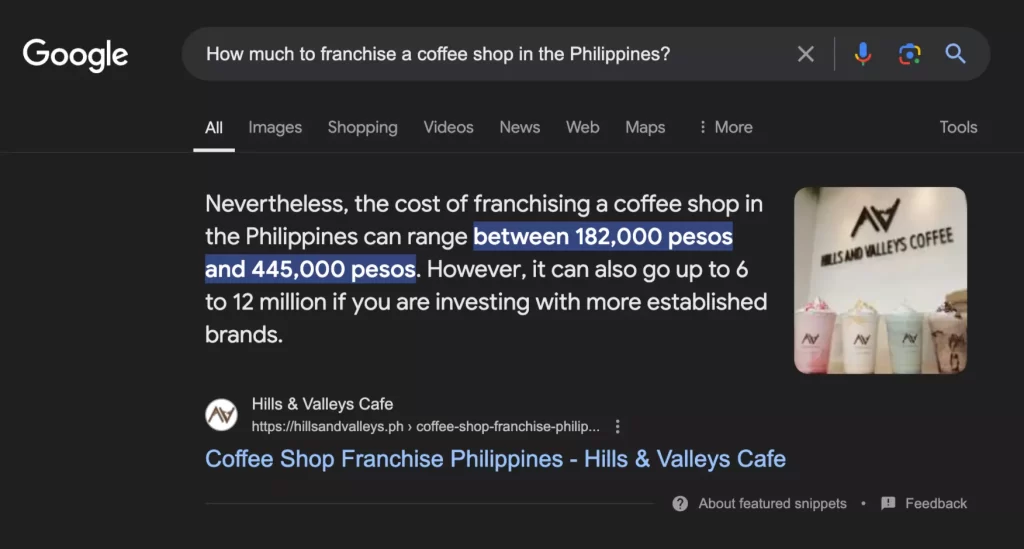
Now, this brings us to the next component of creating people-first content:
EEAT (Expertise, Experience, Authoritativeness, Trustworthiness)
By now, we should have known this populating all over SEO blogs. The ability to integrate EEAT into your content matters ─ here are few tips to leverage this:
- Comprehensive Author Details: Showcase the author's experience, expertise, education, achievements, and social media links to showcase their credibility (authorship SEO). A detailed bio builds trust and authority.
- Proper Sourcing & Citations: Cite reputable sources to demonstrate that your content is research-based and factual, enhancing trustworthiness and depth.
- Including Credible Stats or Expert Quotes: Incorporating statistics or expert quotes can boost content visibility and authority by 30-40%, providing evidence-based information that supports your claims.
- Accuracy of Information: Ensure your content is accurate, especially for industries like YMYL (Your Money, Your Life). Update facts and data regularly to maintain integrity and ethical standards.
- Editorial Process, Disclaimer, and/or Disclosure Statements: Include disclaimers, disclosures, or editorial policies to add transparency, authenticity, and clarity about the content’s intentions or potential biases.
Ahrefs has solidified its brand marketing by incorporating credible authors and experts to contribute insights and quotes to its blog posts, boosting the pages’ credibility and search performance.
Originality & Information Gain
Google emphasizes originality and information gain to combat the issue of copycat content. The goal is to provide unique insights that add value beyond existing content. Here’s how to enhance originality:
- First-Hand Knowledge: Share personal experiences, unique insights, or innovative ideas that address unmet needs. This will set your content apart and position your brand as an expert, potentially earning hard-to-replicate DR 90 backlinks.
- Original Research & Data: Conduct your research or gather data through surveys, experiments, or analysis. If you can't collect data, source it from public databases and present it from a unique angle to offer fresh insights.
- Provide Self-Sourced Images: Use original visuals like screenshots, branded infographics, product photos, or personal experience images to add authenticity and relatability. This makes your content more trustworthy and distinctive.
When incorporating experiences into your content, include what made you feel, see, touch, and taste ─ these are five senses only a person with actual experience on the topic can share in the content.
Give Depth To Your Content Assets
One of the WOSCON 2024 speakers, Kasra Dash, mentioned during the panel Q&A that building topical authority on a website requires publishing more pages within a relevant subject and achieving depth through topics that haven’t been published elsewhere.
Identify subtopics that could be expounded into single blog posts. Based on your expertise and experience, think of topics you can add more depth by giving more information on the “how-to” or new insights from real-world practice.
You can also publish internal data studies that align with topics to validate and support points. This is also an additional content asset that attracts new links to your page.
3. Build a Link-Earning Flywheel
Link building through manual outreach is becoming more difficult these days. Asking for inclusion or requesting a link requires newly contributed content and a solid reason for linking.
This is one primary reason why building a link-earning flywheel on your site gives you leverage to earn passive links without the constant need to do email outreach.
Here are a couple of ways to build a link-earning flywheel:
- Invest in ranking content assets for informational queries other publishers are searching for when looking for additional resources to reference in their content work (e.g., how-to, statistics, data, etc.).
- Provide direct answers to posts’ FAQs and industry questions to get featured snippets.
- Create high-utility content like tools, calculators, or quizzes that intently help solve your target customers' problems.
- Engage in thought leadership. Participate in webinars, podcasts, or industry forums to establish authority in your space and attract publications that will link to your insights or expertise.
4. Brand Positioning via Content Promotion
Contributing content to other sites in your industry positions your brand from a place of authority, as you provide new insights that can add to the body of knowledge in your industry.
Here are ways to position your brand through content promotion:
- Promote your content assets by linking to them from content you distribute on other blogs (i.e. guest posts).
- Create media lists for your digital PR campaign and build relationships with journalists and publishers. If you receive requests and notifications for expert quotes, have your client respond to them (as they’re likely to get a positive response).
- Use Ahrefs to find pages with many links (>100). Create something better and pitch as a replacement.
This link-earning flywheel generates momentum over time, as quality content attracts new backlinks, and these linking pages also attract links on their own.
5. Maximize Rankings for Low-Hanging Fruits
Low-hanging fruit are keywords that are easier to rank for and can quickly increase traffic to your site. Optimizing content for these keywords can help your startup gain quick wins and establish your brand authority to tackle more competitive search terms.
Here’s how to identify and leverage low-hanging keywords:
- Use tools like Ahrefs, SEMRush, and Google Search Console to find keywords you’re already ranking for but aren’t in the top positions (e.g. position 5 to 20). These are opportunities where a little optimization efforts can significantly improve rankings.
- Target low-competitive long-tail keywords. For instance, you can write more specific topics like “best solo travel destinations in Southeast Asia” or “affordable family vacation spots in Europe” instead of targeting “travel destinations.”
- Optimize and upgrade existing content to include low-hanging keywords (discovered through Search Console or Ahrefs). Update headings, meta descriptions, image alt text, and internal links to reflect the targeted terms.
This strategy works because it allows your startup to achieve quicker SEO results. As you gain more authority and organic visibility, it helps you dominate other terms, mainly commercial queries, which brings additional revenue.
How to Get DA 90 Backlinks in 2024
Securing backlinks from high-authority websites can be a game-changer if you aim to rank for highly competitive keywords in Google’s SERPs.
Sites that can provide you with Domain Authority (DA) 90+ backlinks, in particular, are among the most powerful backlinks you can acquire, as they come from sites that Google views as highly credible and trustworthy.
In fact, having a few DA 90 backlinks when you’re just initiating a link building campaign could provide significant results to its destination page—we’ve seen it happen with our own web properties and clients in our link building agency.
In this article, we will explore proven strategies for securing those coveted DA 90+ backlinks, which will give your website an extra boost to outrank the competition.
1. Get Product Links from Comparative Pages
This product-led link building campaign aims to effectively dominate the top page of Google’s SERPs by being as visible as possible. By ensuring your product is featured on multiple comparative pages, you create a multi-touchpoint strategy where potential customers encounter your brand repeatedly while researching solutions.
Comparative pages, such as “Top 10 Healthcare CMS Tools” or “Best POS for Restaurants in the Philippines”, help readers compare different products or solutions within a niche. They often get the most search traffic by ranking for investigative queries.
Aim for inclusion from these pages as you reach out to the authors or website owners. You can offer a trial or free access to your product so they can experience it firsthand, making it easier for them to include your product with a genuine recommendation.
If link inclusion is not possible, identify a niche segment in which your product could be considered the top choice, as it delivers the most value compared with other solutions.
Identify high-authority websites that frequently publish comparison articles in your niche. You can use Ahrefs to find these pages with DA90+ sites quickly. Contribute a comparison article featuring your product as a go-to choice for a niche segment solution.
2. Podcast Mentions Using Podscan.fm
Podcasts are an increasingly popular platform for thought leadership and offer an often-overlooked avenue for acquiring high-quality backlinks.
They are a robust arsenal for brands that attract multiple guests for their personal stories and expertise.
You can use Podscan.fm to monitor all podcasts for mentions of you (as a personal brand) or your company. It sends alerts if you get a new mention.
I tested this out by entering a marketing thought leader, “Mark Schaefer".
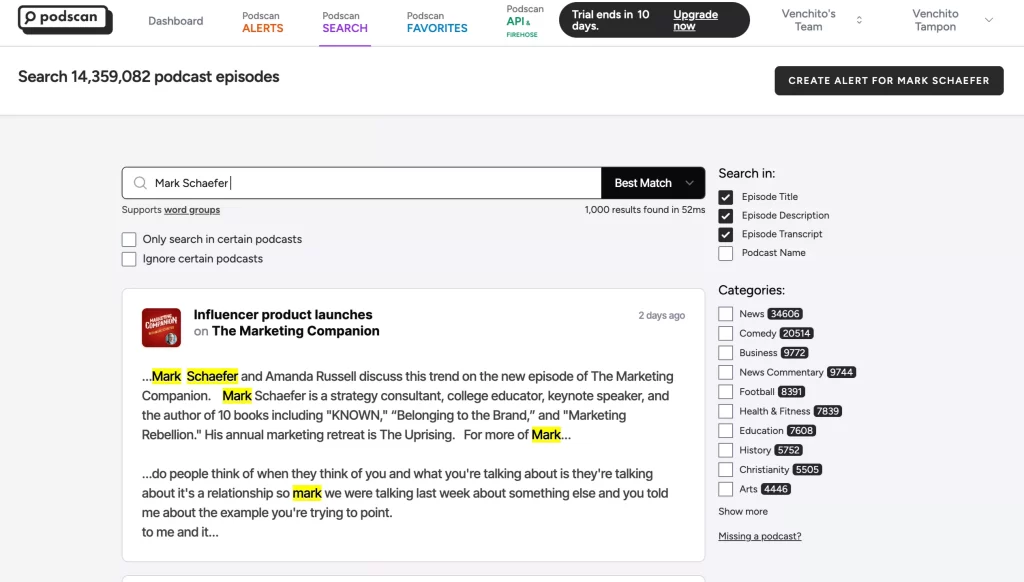
Another way to leverage this tool is to identify podcasts that feature either competitors or non-competitors in your niche or industry.
Reach out to hosts with a pitch on why they’d want you to be a guest. Highlight your credentials, expertise, and unique insights. Once featured, provide the host with a list of links that are included in the show notes, such as links to your website, articles, or resources that offer additional value to their listeners.
3. Recurring Links From Content Partnerships
If you've been following the SharpRocket blog for a while, you’ll notice I’m a strong advocate of content partnerships.
The strength of this link building strategy, compared to other forms, is that it isn’t easy to replicate by your competitors. Content partnerships require access to relationships and collaboration—obviously, anyone cannot manufacture relationships.
Content partnerships can also drive recurring links instead of a one-time link from a unique domain. While most SEO authors vouch only for getting as many unique referring domains, having recurring links from DA 70 sites helps you build more trust signals to your site.
Start getting recurring links by offering to cross-promote each other's content assets through reciprocal link building—linking to highly relevant pages. If your site has a lower DA than the site you’re proposing to, you can use other angles or resources to match the partnership—it could be sharing the link to your newsletter or social media platforms.
The key to success in a content partnership is always determining how to bring the most value to the other party.
Another approach is co-authoring in-depth guides or reports, where you and the partner site share expertise. This leads to mutual backlinks from their high-DA site and future inbound link opportunities from other authoritative sources linking to the content asset.
4. Utilize Digital PR Campaigns
Digital PR has been an integral part of SEO campaigns for creative SEO agencies today. It leverages newsworthy content or stories to attract attention from high-authority sites, earning DA 90+ backlinks.
Unlike traditional link building, where it heavily relies on the efficiency and impact of outreach campaigns, digital PR focuses on the credibility of the content, its uniqueness, and timing in building relationships with journalists and influencers who can amplify your content.
I’ve covered this in our previous guide on digital PR best practices, but let me share more meat to it:
- Create compelling, data-driven, or unique stories that include original research, survey results, expert commentary, or thought-leadership articles. Having content related to your product offerings is a plus; this can lead to more product-led links that assist you in achieving your business goals.
- Use PR tools like Qwoted, Help a B2B Writer, and Connectively to connect with journalists looking for exclusive content or expert insights in your niche. Respond quickly with the correct information to get quoted in their articles.
- Maximize new product launches or industry insights in developing press releases for significant announcements, as brands with creative online launches can catapult to many DR 90 backlinks.
5. Product-Led Content Assets To Earn .Edu Backlinks
Offering scholarships to get .edu backlinks has been a staple link building technique in the industry. Getting scholarship links from a scholarship list page with hundreds of external links to various scholarship programs is getting lesser in link value.
The way to go forward in earning .edu backlinks is by producing content assets that address audience needs while demonstrating how your product or service can solve users’ problems.
To achieve this, you can create in-depth, authoritative guides, tutorials, or research-based content highly relevant to educational institutions. For instance, you might create a guide on emerging technologies that interest computer science departments. It could have a tool section where one of your products can be an obvious solution.
Reach out to university librarians or student resource coordinators who offer your guide as an additional valuable resource for their students or faculty.
Consider creating resource pages designed to complement a university’s curriculum, making it easier for them to link to your comprehensive guide.
Does your brand need high DA backlinks? Contact us to discover link building services to improve your site’s ranking and overall search performance.
Link Building Prospects Approval: Streamline Your Process for SEO Success
Link building prospects approval is one of the overlooked aspects of link building, yet it is the determining factor that separates a successful link development campaign from mediocre ones.
Assessing backlinks based on quality, trustworthiness, and potential impact on website traffic and business objectives empowers your SEO campaign to achieve both its quick wins and long-term goals.
You could have thousands of link prospects, but without a strict quality control process, you’re likely to acquire irrelevant or low-value links that will not increase your site’s organic traffic.
Essential Criteria for Evaluating and Approving Link Building Prospects
The primary question, especially for SEO beginners, is, “What should I consider when evaluating backlink prospects?”
The quick answer to this: topical relevance, quality of the site’s backlink profile, engagement, and targeted traffic sources.
James Norquay has shared a recent experience of one of the backlinks acquired by an SEO agency to a client.
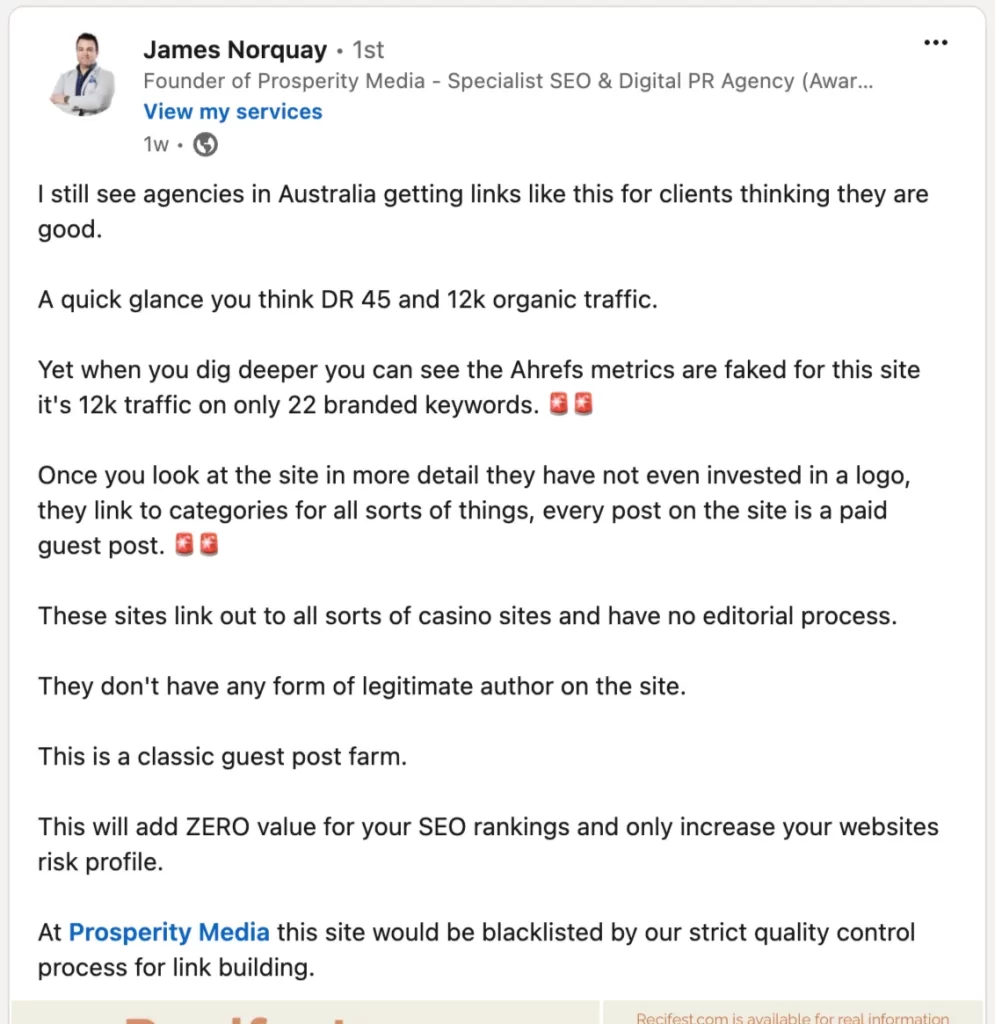
Those examples (and types of links) will not improve the client’s SEO rankings and could risk the site’s link profile.
Our link building agency has a simplified yet strict backlink qualification process. We do it pretty much manually (with the help of a few link analysis tools to quickly determine either the page or site authority score).
Link qualification will vary from industry to industry, the content assets available and their context. But essentially, these criteria are a solid list of control measures.
Site Legitimacy and Branding
When assessing backlink prospects, it is crucial to examine the site’s legitimacy and branding. A quick review of the website’s visible elements—such as its design, logo, social media profiles, About Us page, and Contact details—provides clues to whether an established entity genuinely owns the website.
Another way to confirm the site’s legitimacy is to check its blog author or contributors page, legal disclaimers, and history of consistent content production. These indicate a serious established presence in its niche.
For some instances, you can run the main author picture in Google Reverse Image search to see if the images used have been downloaded from stock photo websites.
Topical Relevance
Topical relevance in the scope of the target customer base is an essential factor in link building decisions.
Make sure the site’s content aligns with the industry or niche to ensure that the links obtained will be contextually appropriate.
Fact to tell that Google’s algorithms reward relevant links, so make it a top priority to choose sites whose topics closely relate to your own. Review their blog posts, product pages, and overall theme to verify that they consistently cover topics that naturally link to your website.
Quality of Website’s Backlink Profile
Evaluating the quality of the website’s backlink profile provides insights into its authority and trustworthiness. Link analysis tools like Ahrefs and Moz can help assess the strength and diversity of a site’s backlinks.
Check for anchor text usage, especially if it is mostly natural or branded, to avoid sites involved in link farms. You can check 3 to 5 recent articles or blog posts and click on some internal and external links.
Avoid sites that primarily link to spammy, unnatural, low-quality sources or from high-risk niches like casino (unless you operate in those verticals), as these can negatively impact your site’s SEO efforts. Instead, focus on prospects with a strong, reputable backlink profile that reflects credibility and authority within the domain.
You can filter links based on the default Ahrefs’ Best by Links feature—dofollow, in content, DR30+, and Traffic of 500+ (or customize based on your link benchmarks).
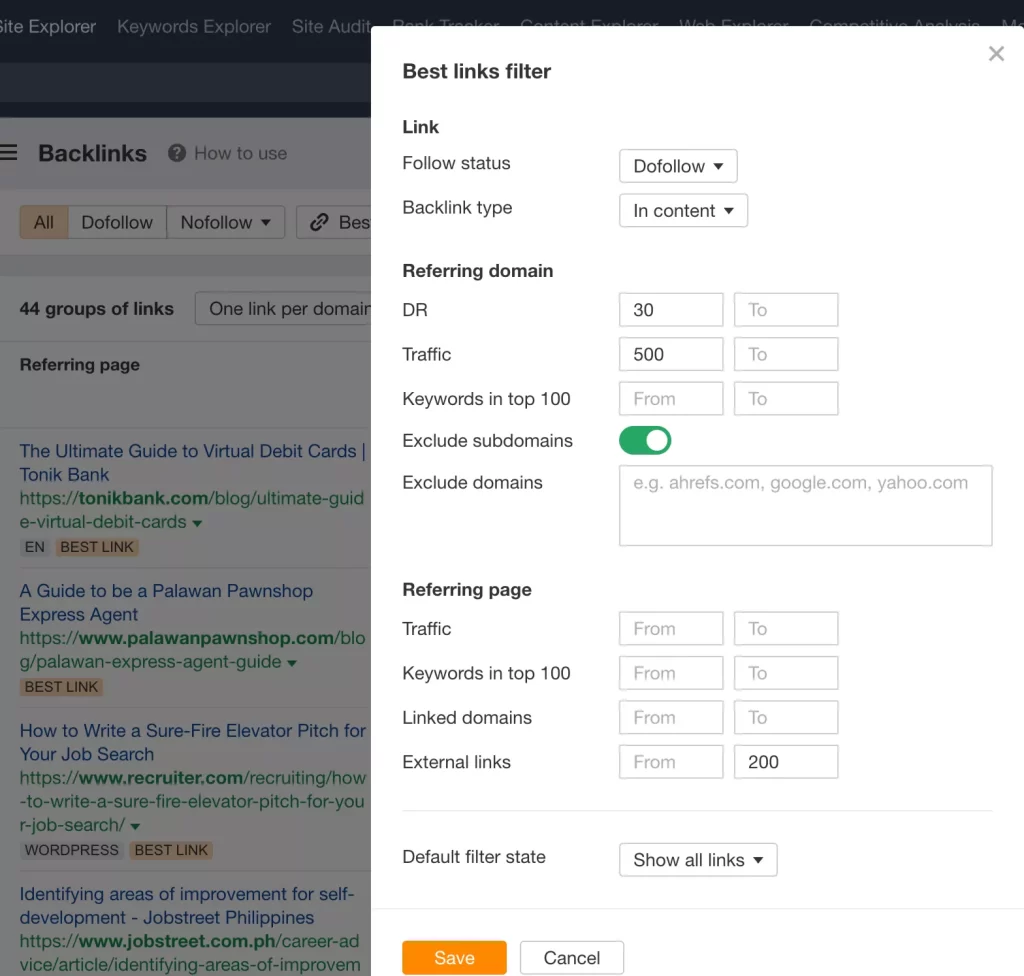
Targeted Traffic Sources
Understanding where the site’s traffic comes from can help you determine whether you’re likely to get additional value in the form of referral traffic as you acquire the link.
If you’re trying to rank for search results within the APAC region, evaluate domains if the traffic primarily comes from related countries such as Singapore or the Philippines.
A well-targeted site will have a steady flow of traffic from search engines, and relevant sources are more likely to drive qualified visitors to your site when the link is placed.
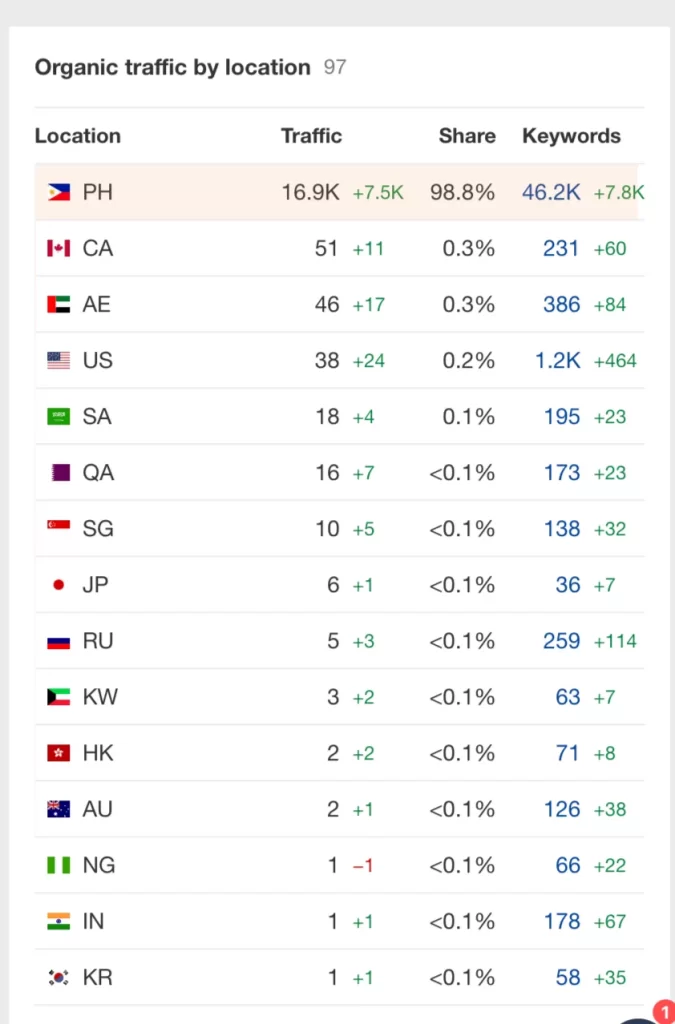
See the traffic graph if pages dropped in traffic—it could indicate that the site got hit by penalties. While a few sites recovered in the recent Core Update, most domains didn’t have the expected light of the day, so double-check for any traffic drop.
Prioritize sites with targeted traffic that aligns well with your audience, as it can boost the chances of gaining relevant referral traffic.
Optimization Tips to Improve Link Building Prospects Approval
Having a diverse set of link building clients allows us to optimize our process to get more approved prospects. By working with different industries and brands, like our SaaS client with strict guidelines or an eCommerce brand targeting niche markets, we customize our approach to meet varying requirements.
Our adaptability mindset as a team ensures a more efficient SEO outreach process. It helps increase the chances of approval for each prospect (especially when working with high-caliber in-house SEO teams).
Create DNC (Do Not Contact) Database
Establishing a "Do Not Contact" (DNC) database is critical to optimizing link building efforts. This database should include websites that are either unresponsive multiple times or unsuitable for your link building goals.
For example, websites that require payment for links (if your strategy doesn’t resort to paid links), sites that lack direct contact with editors or webmasters, or those with no identifiable point of contact should be added to the DNC list.
This prevents your team from wasting time and resources on low-potential prospects and keeps your outreach efforts more focused and efficient.
Revisit and Re-Outreach Sites That Do Not Respond To Acquire More Links
Not all outreach attempts yield immediate results, but that doesn’t mean they should be forgotten. Revisiting and re-outreaching to sites that didn’t respond initially can help you acquire more backlinks over time.
When working with in-house teams or agencies, it’s critically important to maintain a record of backlinks prospects who have been contacted by outreach specialists, marking them for follow-up after a set period (e.g., six months).
Ensure that key details, such as the date of the initial outreach and the name of the person contacted, are included in the sheet (or platform for inputs). This allows for a systematic re-outreach process, enabling you to capitalize on opportunities that may have been missed in the first attempt.
Constantly Improve Link QA Process
The digital landscape is constantly evolving, and with frequent Google updates, developing your link building campaigns is crucial.
Review and refine your Link Quality Assurance (QA) process regularly by discussing updates with your SEO team. Incorporate new criteria to ensure the backlinks you build to meet the latest standards.
One potential addition that I’ve seen with most in-house SEO teams is the consideration of EEAT (Experience, Expertise, Authoritativeness, Trustworthiness) elements.
Websites that demonstrate these qualities, such as those with reputable authors or recognized subject matter experts, should be prioritized in your outreach efforts.
Given that the sites hosting their content contributions are seen as trustworthy by search engines, getting links from these sites can help maintain the long-term effectiveness and holistic approach of your link building strategy.
Do Not Settle with Face-Visible Elements
While it may be tempting to approve link building prospects based on superficial factors like a well-designed website, author pages, or a polished “About Us” section, it’s crucial not to stop there.
Investigate beyond surface-level elements to ensure long-term elements. Check the site’s backlink profile, as this provides a more accurate picture of its authority and trustworthiness.
Examine the site’s backlink history and identify potential red flags, such as many toxic or irrelevant backlinks. By taking this extra step, you can ensure that the links you acquire come from sites with solid reputations, thus improving the overall quality and impact of your link building campaign.
This approach not only helps maintain the credibility of your backlink profile but also strengthens the overall SEO strategy, avoiding potential search engine penalties.
